#it also bugs me in part because this so very much a western culture thing were women historically would change their last name
Explore tagged Tumblr posts
Text
this might be an unpopular opinion lol but I hate evan kinard as a name. i need them to keep their names as is or hyphenate them into buckley-kinard/kinard-buckley.
like I'll read a fic and it'll suddenly go down some monologue about how much buck hates the buckleys and his last name and how he wants to get rid of it. and idk I just don't think that's the case. buck for some odd reason doesn't hate his parents as much as we the audience hate them. he maybe doesn't like them but he doesn't hate them as much as we do. tommy also doesn't like his dad, he's compared his dad and gerrard and said they're basically the same. neither of these men have good relationships with their fathers.
if we're saying buck would jump at the chance of changing his name, why wouldnt tommy also jump at that chance? maybe he wants to become a buckley cuz at least buck and philip have seen each other in the last year? heck maybe they make up a whole new last name and they both change their last names. idk. I have a bone to pick with evan kinard as a name lol I guess I just don't get why buck needs to change his last name to get away from the buckleys or w.e. when the person he's with also has a bad relationship with his father lol
#this is all cuz i was reading a really cute fic and they agreed to keep their last names only for the last chapter to change that#and the reasoning doesnt make sense to me#it also bugs me in part because this so very much a western culture thing were women historically would change their last name#and this just feels like a continuation of it#where im from culturally no one changes their last name so a part of me doesnt understand this obsession with buck changing his last name#esp when the person hes with has an equally awful relationship with his own father#this might very much be me just not getting a cultural difference cuz no one in my life has ever changed their name after getting married#its just not a thing for us and i have never understood this name change thing tbh#saf rambles#saf.txt
40 notes
·
View notes
Text
Since people expressed interest in the comments about the music I used to write my current fic, I wanted to share some of what I explored to write it. I don't think that you need to know this canon or have read this fic to read this post, though I do spend a bit of time talking about how canon influenced the choices I made. Anyone who has been following this fic knows that it was supposed to be porn, and largely, it really still is for the most part a fic about sex. But I did do a lot of research on music with which I'm frankly not very familiar, and the process was really rewarding.
The fic is Time Signature, if you're interested. This post has a lot about music, electronic music, Chinese music, and music theory, as well as some links to music that interests me and inspired portions of the fic. I don't expect anyone to read anything this long, but it was nice to write it.
Canon. One of my favorite things about both book and drama canon is how in synch WWX/LWJ are cultivation-wise. It’s not just that they can predict the talisman the other will use or the seal the other will cast; they also have the same hunches solving mysteries, the same instincts protecting others, the same ideas about where to go. When writing an AU, it’s important to me to show that synchronization (beyond physical attraction and sex), mostly because I think it’s hot.
In canon, however, WWX revolutionizes cultivation, inventing a whole new method when no one ever thought that possible. I also think this is hot. I also think it’s hot if LWJ thinks it’s hot. Look, canonically, LWJ disapproves of demonic cultivation because it will injure WWX’s spirit and body, but imo there is a reason LWJ is so into WWX, and it’s not just because WWX bugs him. It’s not even just because WWX is really cute and happy and exuberant and everything that’s the opposite of his upbringing. I also like to think that it’s because WWX is a fucking genius, and LWJ doesn't mind the idea of upending tradition and the entire cultivation world as much as it really seems at first that he would; he just struggles with anything that could hurt WWX. So anyway, WWX being revolutionary, in basically a technological sense, is important to me.
Wangxian both play music canonically. LWJ’s playing is noted to be particularly powerful, and WWX’s chosen music is at least one part of his revolutionary cultivation method. Additionally, the song LWJ writes for them is an important plot point. It makes sense that in a modern AU, music is a point of connection, so that is what I chose for their careers.
The final point about canon I want to make in connection to the music for this fic is that this is a Chinese canon with Chinese characters set in China. I don’t think it’s wrong to write AUs set in the west. I have done so, and I think there is value in examining a Chinese canon that has become very popular in the west through the lens of the Chinese diaspora. But I also think that there is a lot of value in a western person such as myself trying to learn and understand the cultural context for a canon that I really like, even if I sometimes get it wrong.
I had decided to set this fic in China because I thought the setting would not strongly feature, which would give me an easy “in” to write something set in a place I don’t know much about. Directly after choosing the setting I chose their careers, which made me realize I needed to do a lot more research—both about the careers but also about the setting--than a fic that was supposed to be mainly porn should have really required.
Music genre choice. Lots of AUs I’ve read have Wangxian’s mutual interest be that they both play western classical instruments. This baffles me, but it’s what I’ve seen, so I loosely started there—ie, I spent some time thinking about what would be revolutionary in western instrumental music, which entailed doing some research on contemporary classical music. There are obviously pioneers in any music genre, folks doing new things, but it turned out I just did not know enough about this genre to really understand what would be truly avant-garde.
I took a step back and thought about the instrumental music I have personally heard that feels really new and different, and Philip Glass was the first thing that came to mind. I first heard of Philip Glass when I saw The Hours, for which he wrote the soundtrack. I still think that soundtrack is one of the most beautiful things I’ve ever heard, and I did use it as inspiration for music in this fic, particularly LWJ’s. More on that later.
Philip Glass is great, but for all his eastern minimalist influences, he is a strong figure in the western paradigm. I did some research on Chinese contemporary instrumental music, but most of what I found had a really western flavor. I think there are two reasons for this—one is that I am in the west searching for articles in English; for all that we like to imagine the internet is universal, search algorithms and search history is actually making it far harder than it used to be to find material with which you are completely unfamiliar. Secondly, western music did in fact have a notable impact on Chinese music, which is fine, it’s still Chinese, but I worried about everything I wrote just sounding like it was about western classical, which is a concern of mine I’ll address more later.
Since I wasn’t finding what I wanted, particularly for WWX, in the “art music” (aka, lowercase “c” classical music, which Wikipedia says is also known as “cultivated music, serious music, or canonical music”—ie, instrumental music with strings, winds, percussion) scene, I realized I needed to examine the other contemporary music, by which I mean everything else. Since I am most familiar with rock, Radiohead immediately came to mind, but Radiohead is a band, and there are lyrics. Though the lyrics are not where the meaning of Radiohead songs lie (the vocals are treated as largely instrumental), if there were lyrics, I’d need to write about them, and I didn’t want to. More importantly, Radiohead is singular in what they do, which makes them difficult to categorize, and this makes them difficult to describe textually. You can say that Radiohead revolutionized rock, or even reinvented it, but that is not really addressing how fundamentally avant-gardeRadiohead is. Describing how revolutionary Radiohead is on paper really is just saying “but they’re different!” over and over again.
What I needed for WWX was a music genre that was revolutionary, an entire school of music that felt cutting edge and frankly, unfamiliar, and for that, I realized I needed my brother.
Some stories about my family. My brother is a music artist who creates electronic music. If you want to understand why it took me this long to get to my brother in this thought process, you should understand a few things about him. First, I love him a lot, but we’re not very close. Second, my brother is probably the quietest person I know—like, idk, LWJ levels of non-talking. Last, I do not understand my brother’s music. I’ve tried! I listened to it a lot! But when I didn’t understand, I asked questions, and my brother cannot explain any of it. He’s an expressive guy! Just not verbally, and as a very verbal person, I have a tough time when people cannot use their words. Like, even asking him what type of music he plays, he’ll say something like, “It’s complicated.” (This is a lie. He’ll look at me and say, “Type?” And I’ll try to explain what I mean. And he’ll say, “I don’t know.” And if I said, “Okay, but if you had to label it?” He’d laugh and say, “Why?” And if I said, “So I can better understand your music,” he’d think for a long time, then look very frustrated, and laugh, and say, “I don’t know?” I think we’ve literally had this exact conversation).
Anyway, possibly through one of these type of exchanges, where I’m grilling him like a school marm and he’s acting like I’m making him take a standardized test he hates (I’m his little sister. Would it be easier to subject him to these horrors if he was my little brother?), I learned that one of my brother’s influences is Aphex Twin. My brother loves Aphex Twin. I . . . don’t. I’ve listened to a lot of him (in order to understand my brother better); I do not like it, and I do not understand it. My brother talks about Aphex Twin like he’s a genius (if and when my brother talks at all). Now, my brother is a very smart guy; it’s not that I didn’t believe him when he said Aphex Twin was a genius, but he also gets . . . swept up by things, and as previously discussed, he doesn’t talk a lot, so I didn’t really understand what my brother meant by this. It took hearing about Aphex Twin randomly, in a couple other places, for me to realize Aphex Twin is a Big Deal. When I looked up Aphex Twin at some point in order to better understand the music my brother makes, I found that Aphex Twin is considered by many to be a genius and also a pioneer. Apologies to all of you who already knew that about Aphex Twin.
Sidenote, my brother’s wife is also a musician, though not professionally. She could have been, considering that she was ranked as one of the top flute players in Texas, and Texas is fucking huge. But no, professionally, my sister-in-law is in cognitive science and linguistics, which you may remember was the career LWJ had in Say More (my fiancée is also a linguist. I also know a few other linguists. My life is convenient for my Wangxian AUs, I gotta say). I mention my sister-in-law because my sister-in-law has enough musical acuity to also recognize that both my brother and Aphex Twin are geniuses, which really helped me to understand that even though I’m not really into this music at all, it really is a Big Deal.
So, I researched Aphex Twin and also went to my brother’s website for his music to find out what the hell this type of music is called, and it turns out there’s not a good name. IDM, which stands for intelligent dance music, is a label Aphex Twin himself famously does not like, and my brother labeled his own music as “acid, techno, house, electro.” Wikipedia said that Aphex Twin is known for techno, ambient, and jungle.
Anyway, into this confusing morass of electronic revolutionary music is where I decided to plunk Wei Ying.
Electronic music. Note for this section that I know nothing about electronic music. I’m writing this post partly to document the journey of discovery I went on to write this porn. I’m not really trying to educate anyone so much as I’m trying to provide insight as to what I researched for this fic and what the references are, in case the fic interested you.
When you really get down to it, music made with electronics has as many genres and styes as music made with more traditional instruments, and the labels are just as confusing (see this Wikipedia list of electronic music genres). For instance, “electronica” just means music made with electronics to some people, but to others it’s more specific. You’ve also got a bunch of other terms: ambient, EDM, techno, house, IDM.
This is all based on what I learned from Wikipedia, but here are some loose definitions as I understand them: There’s ambient, which is really made for background listening, and then there’s EDM (electronic dance music), which is made for active listening—ie, dancing. Within EDM you have lots of genres, such as techno; techno is usually characterized by a specific tempo and repeating structure, and house, which . . . is also characterized by a specific tempo and repeating structure, but the tempo is different. From what I can gather, house is also a bigger tent than techno; ie, many different genres and styles can be house, but techno is more often just techno. (Note that part of the reason all of this terminology has so much overlap is that it originated in different places; techno was invented in Berlin, house in Chicago.) Meanwhile, the list of genres of house is so big that it also has its own Wikipedia page, which is almost as large as the list of electronic music genres.
Note that there is such a thing as “house ambient”, which explodes the entire concept of ambient vs EDM. To aid in that explosion, IDM is described on Wikipedia as including styles such as ambient techo, and “is regarded as better suited to home listening rather than dancing.” What stands out about IDM, and the reason it is featured in the fic, is that it’s known for being experimental. (I’ll add that it emerged in the 90s, which isn’t great for my fic. Whatever WWX is doing, he is on the edge, and 90s music already old to him, even if he’s Aphex Twin’s biggest fan! But alas, my research could not tell me what is happening right now, because you really have to be involved in The Scene to understand what’s new. By the time it’s documented, it’s already really a little old.)
If you are researching electronic music and how it is revolutionary, you’re probably going to get into its evolution and history, since this is a new style of music. And if you are looking into the origins of this kind of music, you’re going to find Brian Eno. And if you’re looking into Brian Eno, you’re going to find minimalism.
Minimalism. Brian Eno is an extremely famous dude. I’d probably heard of him before, but I am very good with big concepts and pretty bad with details, so because I didn’t know anything about the bigger concepts behind ambient/electronic music/minimalism, I never paid attention. Now I’m hearing about him literally everywhere, which is funny, since it’s not like he’s new news. Ezra Klein was literally waxing poetic about Music for Airports just a month ago.
Eno is famous for his pioneering work in ambient music and electronic music, and, as one might expect, electronic ambient. Eno was always doing experimental, avant-garde stuff, and early on he embraced a minimal style. He later coined the term “ambient music.”
What’s interesting about this is that around the same time as Eno was doing this in later 1960s/early 1970s, a new kind of art music was being born in classical circles. This is the capital “M” Minimal music, for which—you guessed it—Philip Glass is really famous. And when you look at Philip Glass’s influences, he was deeply influenced by the minimalism of eastern music, especially Indian and Tibetan music. I couldn’t really find anything saying that Brian Eno was directly influenced by traditional eastern music, but Eno is definitely a fan of Glass and vice versa; they really build on each other.
This ended up just being a very cool intersection for the fic that I didn’t plan. I didn’t end up using it very much, but I must say I was stupidly pleased that the kind of music I was looking into for both of these characters has such deep roots in eastern music traditions. So now let’s talk a little bit about eastern music, specifically Chinese music, since that’s where this fic is based.
Chinese music. I did read a bit about Chinese music for this fic, and I have to say that I still don’t know a lot about it. As stated above, I’m in the west, using my western search techniques, looking for primarily articles in English (though I get Google to translate some things). I also just have a western understanding of music and music history, and it turns out, surprise, different cultures are different, and my entire paradigm for understanding music does not really apply to music from other cultures.
I, and many of us, want music to be a universal language, something that can move through all barriers and touch us in our souls. And it is! I have listened to and loved music not from my culture! But thinking of music as something intrinsically universal and therefore immediately moving to everyone really collapses the rich history of musical tradition all cultures have. Music really is like a language, in that it is built on the culture that creates it; it has its own internal logic; it has style and meaning that depend on the history of that tradition and the understanding of its audience. The brief reading I’m going to do to write some porn will not give me to understand the deep and rich tradition of Chinese music, but also, frankly, even if I turned all my efforts and career to learning and understanding this right now, I still would not have the best comprehension. I don’t even comprehend western music, and I grew up with it. So, forgive me for the paucity of my understanding and knowledge, and please correct me if I make mistakes.
When I think about Chinese music that I know about, I think of two things: modern and traditional. The modern stuff I’m thinking of is stuff like C-pop, but also the things you might hear on the soundtrack for a drama or movie. To me, none of this music sounds that different than western pop or western soundtracks. There are a few reasons for this: one, there are tons of Chinese music that is not reaching me. Two, maybe I just think it doesn’t sound that different because I can only really process what I recognize. Three, in a similar vein, maybe I’m thinking “that sounds like what I know” when really what I know sounds like what I’m hearing. Globalization is definitely doing things to music; if you’re telling me that Asian pop is not influencing western pop right now, I’m going to think you’re crazy, considering the influence and popularity Asian pop has in the US and Europe right now. And four, western music did have an impact on Chinese music, so there’s that.
Obviously, the music genre I chose for Wei Ying falls into the modern sphere, and I certainly looked into the techno/EDM/IDM/electronic/ambient/house scene in China. Articles I found stated it took a little longer for EDM to pick up steam in China, but now it’s definitely going strong. There are some great electronic music festivals, EDM clubs, underground EDM scenes, and EDM music artists (composers and DJs!) in China. Researching these artists was pretty difficult, especially because I wanted Wangxian’s musical discussions to be highly technical, and for highly technical discussions about EDM you are wandering into some very niche spaces. I’m sure such spaces about EDM in China exist, but they’re most likely to be in Chinese.
As I’ve said, globalization is a factor when it comes to cultural difference in music, and I’d add here that because this genre of music is so new, globalization has even more influence, from what I can tell. That said, I do not want to diminish how much influence very specific locations have to do with this type of music. EDM is very tied to clubs (because of the dancing) and performance (because of deejaying, and also because of things like live coding/algorave), which is probably why we get so many granular genres of house—Chicago house is different from Detroit, just for example. Regardless, I stuck with researching a lot of western artists for both the music and musical discussions in the fic, mostly because the music is supposed to be so new and avant-garde that is should not be something overly familiar to the reader, even if they’re steeped in electronic music genres.
Then there’s traditional music.
Traditional music. Traditional music obviously had a huge influence on Chinese modern music. The influence of traditional eastern music on modern eastern music, as well as traditional eastern music itself, is what really influenced a lot of western minimalism of the 1960s and 70s (and onward). To be clear, not all “eastern” traditional music is the same. It’s just as richly diverse regionally as traditional western music, if not more so, given “the east” is fucking huge—though I will say that a lot of people think of western music as pretty monolithic, because folk is characterized as a separate tradition than classical. When you consider ancient western folk, there’s a shit ton of it, and it’s quite diverse. There is also folk music in eastern music traditions, and this is different than music that would have been played in courts and palaces, so there’s really a ton going on.
Traditional music is what people think of when they think of eastern music being “weird,” which is something I really hate. Look, I love being weird; I think weird is cool; it’s great. But weird means unusual, and traditional music is very usual; people who say that just mean it’s unusual for them, and they should think about their words. What they’re trying to say is that traditional eastern music will sound very different for many western listeners, even though, again, we like to think of music as so universal, actually!, because it’s based on math, actually!, and math is so universal!!! The truth is that math is patterns, and patterns are things that your brain recognizes when there are familiar elements, and when there are unfamiliar elements your brain has trouble recognizing the pattern. So, again, music is a way to communicate across all kinds of boundaries, but it is not a universal translator. (But it does make you wonder . . . if Lan Zhan played Inquiry, could Aeneas answer???)
Regarding the unfamiliar math, what we’re talking about is scales. I think most people know this part. Eastern scales are based on math, just like western scales, but the frequencies are divided up differently. Among other things, traditional Chinese music did not use equal temperament, which means depending on what note you start with, the intervals for all the notes on the scale were be different. A way of thinking about this, at least as I understand it, is that a piano is even tempered. All the notes are always the same whether you’re playing in C major or B flat, because you have no control over the frequency produced when you press the key. But if you’re using just intonation—say you’re using an instrument with just a few strings—you’re adjusting the frequency of the note to match your scale. It requires extremely precise hearing and playing ability.
Notation for traditional Chinese music was really different than how I as a westerner understand it. For one thing, it didn’t include rhythm, and for another, it represented more a framework for improvisation than every single precise note. (See Gongche notation, Wikipedia.)
Authorship was also thought of pretty differently. When I googled “great Chinese composers,” the only results I was getting were twentieth century. There are some great ancient Chinese composers, but I had to do a lot of digging to find them, and trying to find someone like the Chinese equivalent of Beethoven is just the wrong approach. When you get right down to it, this really seems to be about the fundamental difference between western individualism vs eastern collectivism and community-based thinking. The individual artist is not the hero of the story. That said, the tradition of the music is very heroic. For instance, the notation allows such variation that the same piece can really build and grow through different artists, much like a story through oral tradition. Additionally, for an artist in an ensemble piece to stand out would really be quite rude; the point is not the individual talent of the musicians but the fundamental beauty of the piece. (This was a particularly hard thing to research, and I mostly found out what I laid out above from various folks answering questions in forums. The best one I found is here.)
Another thing is that harmony, as we think of it, was just not really a thing in traditional Chinese music. The focus was on a melody, which is where minimalism comes in. I’d add here that the “as we think of it” is pretty important, because the western paradigm, including western music language, is not super great at really capturing the nuance of Chinese music. I am terrible at tracking my sources when I research stuff for fic, so I was trying to find some of them now, and I came across this article, which examines the harmony that did exist, but how different it is from what we think of when we think of western harmony.
Despite the reading I did on this subject, very little about Chinese traditional music made it into the fic. I do have Lan Zhan reading a book on traditional music that he hates. This isn’t based on a book I found, but rather to show that Lan Zhan isn’t really into the idea of musical “purity,” that is, ideas of what you should and shouldn’t do with music. That said, I’m not really aware of what strictures around traditional Chinese music are like, or what the Chinese thought is on that. I am aware of how deeply restrictive western thought is regarding music theory, and that’s really where that part of the fic was coming from.
I’d originally had Lan Zhan reading a book on western music theory and very deeply hating it, but I also felt like having him read a book on western theory could reinforce the idea that he’s working within a western paradigm, when really the whole point is that this Lan Zhan very intentionally uses traditional music values. Due to his inspiration from Wei Ying, he’s breaking the norms of how that music works, but he's not necessarily making it western; he’s making it avant-garde. Basically, my inspiration was a Chinese Philip Glass, but I didn’t want to say that because as mentioned above, Glass is still western, no matter his influences. That said, Wei Ying does compare Lan Zhan to Philip Glass and also Tan Dun, who you might recognize as the guy who did the soundtrack for Crouching Tiger, Hidden Dragon, among many other very famous projects.
Tan Dun has in fact been called the Chinese Philip Glass, which is probably not very respectful to Tan Dun, who is himself an incredible (and experimental!) composer. I should note, however, that Tan Dun is Chinese American—he was born in China, but got a degree at Columbia and has lived in New York since. Also, he is particularly famous for marrying Eastern traditionalism with western style, and that really wasn’t what I wanted for Lan Zhan. I didn’t want Lan Zhan to be incredible because he was using western traditions, though he is familiar with them and can make very talented use of them. A lot of very famous Chinese modern composer are famous for that, and that music is still very Chinese. That said, I felt that if I made that Lan Zhan’s style, it would feel like I was saying Lan Zhan’s music is special because it’s western, and that was something I really wasn’t keen on.
In the end, I possibly did the fic and traditional Chinese music a disservice by having Lan Zhan read his book and hate on it. One of the whole reasons western music theory sucks is it can be pretty racist, and that’s what I was trying to avoid, but by conflating my rage at western music theory with eastern, I didn’t really help things much. But anyway, since I’ve now mentioned it, let’s just take a slight detour to talk about what I mean by racist music theory.
Western music theory racism. There’s a scene in the movie Tár that really solidified my feelings on the subject. In it, a student who identifies as BIPOC and pangender, says they don’t really have much use for Bach because of Bach’s misogynist history. The extremely famous director, Tár, played by Cate Blanchett, lambasts the student for “cancelling” Bach because of Bach’s personal life. The student goes on to say that they really just don’t have much interest in cis male white composers, and Tár continues to lambast the student for considering things like gender and race in conjunction with the art.
My understanding of this scene was that it was demonstrating that Tár is a jerk, so full of herself that she can’t listen to other voices, and so steeped in her 18th century western ideas of genius that she’s literally silencing the music voices she’s supposed to support. That was not most people’s reading of the scene, and in retrospect, possibly not the intention of the film. It seems rather telling that not a lot is known about Bach’s misogyny or lack thereof; there are plenty of other “great” western composers that are known to be worse in terms of misogyny and abuse, and yet the film did not make this scene about them. In retrospect, maybe that scene wanted to paint this student as kind of ignorant for cancelling Bach, and Tár really puts them in their place when she describes how art is more important than the artist.
Fuck that. I certainly believe that art is more important than the artist. JK Rowling sucks; that doesn’t mean I will stop loving HP fic and the part it’s played in my life. But the ugliness of the scene is that it hinges on importance of Bach, and look here, shocker, Bach is not essential, just as JKR is not essential if you decide you don’t ever want to familiarize yourself with the literature of TERFs. Even if you want to be a musician and create or conduct music, Bach is just not essential.
He’s pretty important if you want to be a western music historian, true, but when we talk about music there are many, many music traditions that are incredibly worthwhile and important that not only weren’t created by cis white men, but also weren’t ever derived or influenced by cis white men. If you think that you need Bach to know and love and create and perform and conduct music, it’s because you’re operating in a single paradigm that has become yes, universally known, but also for that reason oppressive and imperialist. I am not saying western classical music is bad because it’s imperialist, just to be clear. Bach’s great! Hate ‘im, but I do love me some Beethoven and he was also very cis and male and white and also a complete douche! What I’m saying is that forcing this music tradition on others is deeply imperialist, and it happens all the time.
Anyway, this is really a tangent, because despite my very good intentions to write about Chinese music, as I have stated, almost everything I used for reference was western, even a lot of the stuff I listened to. Maybe I just wanted to acknowledge that that’s a little racist, even though I tried not to be. Maybe I also wanted to hate on Tár and leave you with this interesting video about white supremacy in music theory.
References. Finally, we’ve reached the part I had originally intended to post, which is why I started writing this. Below are the essays and articles I used to write this fic. They were used in three ways: 1) to describe the music (though I also listened to things, see next section), 2) to inform Lan Zhan’s critiques and Wei Ying’s ideas—though I read a lot of essays to do that, just a crazy amount considering how little of the fic is actually about that, and 3) to describe the reading material Wei Ying and Lan Zhan exchange.
Music Beyond Airports – Appraising Ambient Music
This is a series of essays largely focused around Brian Eno’s Music for Airports, though there’s a lot of other stuff as well. I didn’t read everything in here, but the collection is absolutely fascinating. “Ambient House: “Little Fluffy Clouds” And The Sampler As Time Machine” is one of the “articles” Wei Ying sends Lan Zhan; meanwhile, the collection as whole is what Lan Zhan sends Wei Ying when he says he’s been reading about ambient house. Additionally, “Adaptive Game Scoring With Ambient Music” really influenced Lan Zhan’s commentary about arpeggiation, the first time he comments on Wei Ying’s music.
Counterpoint - Tracking in the Music of Aphex Twin
I have some embarrassment about this, given that the article is about counterpoint, and as I have discussed above, eastern traditional music doesn’t really employ that in the way westerners think about it. However, it’s also pretty backwards to restrict Wei Ying to traditional eastern music, as modern Chinese music includes plenty of counterpoint, and part of the point of the fic is that Wei Ying is doing entirely new things that haven’t been done before. Well. They’ve been done by Aphex Twin, as described in this piece, which also describes the first piece that Wei Ying plays for Lan Zhan in the fic, in the car. I did lift the phrase “pedagogy of counterpoint,” and could not decide whether it was long enough or significant enough to credit in the fic.
Unequal Temperament: A Review of Aphex Twin’s SYRO
I can’t remember what I used this article for. It’s an interesting read.
Reverb Machine (the entire website)
This is the site I kept returning to over and over and over again. Most of the articles about electronic really focus on either the equipment used or chords. In the fic, Lan Zhan isn’t supposed to know much about equipment or how any of it is used, because he does not do electronic music. Also, I didn’t really want to talk much about chord progressions, because those discussions are steeped in western music theory, and I wanted it to be possible for Wei Ying to be using the kind of scales traditional Chinese music used, even if a lot of modern Chinese music does use an even-tempered 12-tone scale. However, this site has a lot, and I ended up returning to it again and again so Wei Ying could say an offhand thing about reverb, and to describe certain things.
Notably, Wei Ying’s track, sex.mp3 is loosely based around Trent Reznor’s and Atticus Ross’s soundtrack to The Social Network. I haven’t even talked about Trent Reznor, but he was also someone I considered deeply when I started thinking about making Wei Ying do electronic music. In case you don’t know, Reznor was the artist behind Nine Inch Nails, but in later years he moved on to more experimental things, including movie soundtracks. Side note, movie soundtracks and video games is where a lot of these experimental artists doing either minimalism, ambient, or electronica, or a combination of all three end up, and I ended up reading a lot about video game music.
But anyway, when I saw the Social Network, I came out of it 1) admiring Aaron Sorkin and wishing I didn’t admire Aaron Sorkin because he’s kind of a douche, 2) shipping Mark and Eduardo way too much for my comfort, 3) going HOLY SHIT THAT SOUNDTRACK. Turns out I was not alone in finding that soundtrack totally different and new compared to anything I have ever heard, because as it turns out, it really was—wait for it—revolutionary. I understand that I have now said that about Glass, Eno, Radiohead, and Aphex Twin, but hey, people are doing things in music. Like I get that pop and hiphop artists are revolutionizing their genres all the time, but also it is possible for music as we know it to be redefined, and it’s not just the weird shit you hear that sounds like noise (there is a place for the weird shit that sounds like noise, and Brian Eno is closer to it than any of the above mentioned; I am not dissing weird shit that sounds like noise, because it is part of how we get where we are going).
Anyway, I used this website’s essay about The Social Network’s piece, “In Motion” to describe some of the music and inform some commentary on it.
“East Meets West: A Musical Analysis of Chinese Sights and Sounds, by Yuankai BaoSounds, by Yuankai Bao” by Jiazi Shi
This was the only essay I found that really had the extremely niche technical jargon that I really wanted for the fic that was also about Chinese music. You’ll note that it’s about a Chinese composer who is, again, famous for marrying eastern and western tradition, but this was what I could find in English, and I searched a lot. You’ll note that Lan Zhan’s very specific comment about the key change is something very directly inspired by this grad school dissertation. You’ll also note that this is where I found “Flowing Stream,” including a description of the song and the lyrics.
Music. A lot of fics like this one will link you to a specific piece that the character is playing. I could not do that, because the music in my fic is very intentionally made up. As I have been saying, the whole point is that Wei Ying is pushing the boundaries, inventing music that does not exist. So is Lan Zhan, by the end. I listened to music to inspire the descriptions, but it is not what they are playing, and almost none of it is Chinese. I’d be very interested in finding some Chinese music that is working on some of the principles of minimalism and electronic that these pieces employ.
Aphex Twin – Stone In Focus
Now you’ve come to the climax—this is really the story of how I learned to love Aphex Twin. This piece makes me cry. It’s what I used to describe the piece that has the remix of Lan Zhan’s guqin piece from 12 years ago. Obviously, the guqin piece mentioned in the fic is the canonical piece, Wangxian, but I find Wangian in the drama cheesier than I want it to be, and this Aphex Twin piece doesn’t have the Wangxian part. It’s just the sad longing part before Wangxian enters, but you’ll also notice that there are no flutes! Again, this is not the piece Wei Ying wrote; it’s just what I used for the description.
I didn’t link to the YouTube video I was watching, because the video was a collection and this didn’t come on until after minute thirteen. But that video just has this very sad tunnel that looks like maybe it’s for a train, and the rain is falling, and that makes me cry as well: https://www.youtube.com/watch?v=BHl4NVytGpo&t=1074s
Book featuring Ndidi O - Hold On, I'm Coming
Wait, you’re saying, this is not electronic/house/ambient at all; this is just a trick to get me to watch one of your favorite wangxian vids! You’re right! But frankly, I was not focused on the genre when describing the music; I was focused on getting the feel of it that I wanted. The opening sequence to this was what I used to describe the track they make love to. (Lan Zhan starts making out with him and kind of slowly humping him to the track with the wangxian remix, but then Lan Zhan demands he plays something else, and this is what I listened to to get the feel for it.)
This pieces is a cover, and frankly, I can’t find out much about it. But just thinking about it turns me on and makes me cry and makes me feel so much, I can’t do it too often.
Trent Reznor and Atticus Ross – “In Motion,” from soundtrack to The Social Network
As noted above, this piece inspired sex.mp3, but I will say that the article I linked above about this piece, as well as the memory of the soundtrack itself, inspired descriptions more than listening to the piece itself. In the fic, sex.mp3 is initially described as “violent.” This was because I didn’t know if the track would play a big part in the fic, and then when it did, I really had to change to both to fit the meaning and the flavor I wanted; it became “anxiety inducing,” and that’s when it became “In Motion.” “In Motion,” however, is kind of too bright and peppy to really be sex.mp3, though I will say I was trying to listen to it just to write this section of the post, and I had to turn it off. It makes me SO anxious.
Philip Glass – soundtrack to The Hours
I’m linking the whole soundtrack, because in the fic Lan Zhan writes several related pieces, which is what this soundtrack is. I can’t even recommend one piece on this soundtrack, because it’s the thing as a whole that really makes you cry, and I can’t say I listened to a specific part of it to describe Lan Zhan’s music, because I know it so well that I only have to listen to a small piece to get all of it.
Flowing Water, played by Chen Leiji
The part this played in the fic is obvious. I listened to at least five versions of Flowing Stream/Flowing Water, and this is the one that I like the best. However, like all the renditions I listened to, the piece eventually becomes pretty complex and different than I wanted for Lan Zhan. In fact, what the narration describes as “showing off technique” is what I found in all recordings of this piece. I guess if you’re going to play “Twinkle Twinkle Little Star” on YouTube you’re going to do something impressive with it, but I will say this piece is still very close to what I wanted.
I will also say that when I searched for this piece, as well as several other traditional songs, the search results had a lost of stuff that said you can listen to these pieces for tranquility and calm and meditation. I suggest listening to this one as extremely passionate and longing, and you’re going to get a lot more from it. If you resign it to the background, yeah, it’s kind of nice. If you let each note really speak to you, you’re going to really ache in a beautiful way.
Brian Eno – Ambient 1, Music for Airports
After hearing so much about Eno and Music for Airports, I was a little afraid I wouldn’t like it. After all, this isn’t really my genre, and witness how long it took me to find something I liked by Aphex Twin. However, I really needed some inspiration for the piece Wei Ying composes after Lan Zhan breaks them up, so I started listening to it.
The opening to this album is not the heartbreaking thing that the fic describes. It in fact does break my heart, but that is because there is something so sweet about it, lonely and sweet, but also perfectly fine being by itself. This piece is like a child alone in a room, figuring out blocks. This piece is like a cat on a piano, content with its nonsense noise. This piece is what it’s like to be alone and to be fine with that, to love from afar and be fine with that. It still brings me to tears, listening to it.
Radiohead – Everything in its Right Place
Apparently I did not succeed in writing all the music without Radiohead. I will say it happened because I happened to be watching a TV show that just happened to use this song right when I needed something powerful. I was already thinking about them, because my BFF was listening to a podcast about In Rainbows, which explains the children shouting “Yay!” in 15 Step. I really wanted something other than rain to get sampled in Wei Ying’s music, and my brother has specifically used his children talking or his babies crying as samples. Once Lan Zhan knows about A-Yuan, I wanted to use that idea, so I listened to 15 Step again, which is far too peppy for what I needed. But then Everything In Its Right Place came on, and it’s actually way too melancholy for what I needed, but that doesn’t really matter; I just needed to get a few notes described, so this is what I used for inspiration for what Wei Ying plays Lan Zhan after he admits to being in love with him. I will just say that re-listening to this song really does remind me of just how much Kid A means to me, but also how much it means to, like, music. There was really nothing like it at the time.
-
I will end this post by saying that I am not, in fact, a "music" person. So many people need and rely on music to get them through tough times. I mostly don't care about it. I don't have a Spotify account, and I can't imagine taking the time to really curate playlists.
But one thing I can say about me and my tastes is that I'm interested in learning. I want to try new things and hear things that I haven't heard before. To be a little self-aggrandizing, I think that that's a good thing. I think it makes me a better person to work on listening to things that I'm a little unfamiliar with and learn what's great about them. I think I got to do that quite a bit writing this, even though in the end I used a lot of pieces I was familiar with to do the actual writing. I hope that maybe someone reads this and decides to listen to something new, just like I did.
102 notes
·
View notes
Note
One thing that's been bugging me about EOTWR ist that one of their bigger supporters has a post up with over 6k reblogs, where they claim that AO3's elections are rigged and that people should stop voting in them and instead "get angry" and give them "noisy, angry hell on every single fucking platform you can find.", which is pretty much a HUGE red flag. Why? For one, they present zero evidence on OTW's elections "being rigged" and that's an incredibly serious allegation to make. And as we can see with Trump and the GOP, it's an allegation that can be very well used to undermine liberal, democratic institutions and processes, so it should never be used without having serious evidence or at least a solid argument to support it. Nevermind that "don't vote" because "voting doesn't achieve anything" has been a hugely popular propaganda tactic and narrative that neo-fascist, authoritarian governments like Russia have spread via troll-farms in an attempt to sabotage western democracies and as a means of hybrid warfare, so I'm going to give anybody a major side-eye who replicates that kind of narrative, even in a different context. Also, this whole appeal to "get angry and give people hell" appeal? All withouth any kind of recourse to...you know....TALKING with each other and finding a way forward together? That's not something that shows interest in building better policies, that's instigating a harassment campaign against anybody who doesn't fall into line and agrees 100% with you. Which, given the diversity of the fandom community, with a wealth of people from different countries, different cultures, faiths and personal experiences? Also NOT a good idea. So overall....would be more anti-racist action a good thing? Yes. For now though, EOTWR looks to be a poster-child for "the way to hell is paved with good intentions" and has a higher probability of doing harm to fandom rather than good.
--
It's foolish to think OTW elections are rigged when everything about them is entirely predictable from basic popularity contest dynamics that afflict literally all parts of human existence.
Also, it's hard to even get anyone to run, and most candidates are functionally identical to an outside observer in most election cycles. What the hell is the rigging supposed to have done?
122 notes
·
View notes
Text
i have decided to expouse my opinions on the "trans girls vs everyone else" discourse as i have been calling it(i can call it that cuz im a trans girl), largely because i can't stop thinking about it and need to get my mind off it. as with most discourses, it is deeply stupid and consists of several disparate points, which are loosely linked making it somewhat hard to address them one by one but i will attempt to do so regardless, in no particular order.
there appears to be a debate today regarding genders that are not the standard cis binary genders in non-western cultures, specifically those of india. the fact that people on both sides have claimed that a majority of people of that gender they have talked to agree with them leads me to conclude that it probably isn't as simple as "this gender is equivalent to trans woman and that word is a slur" or "this is a third gender and anyone suggesting otherwise is imperialist scum". developing an informed opinion i think would require more people of this gender actually weighing in on the debate, since second-hand evidence clearly isn't working. this one is just kinda a stupid argument and while it is useful due to being emblematic of this discourse as a whole largely consisting of people talking past each other, i mostly just brought it up because it was bugging me right now.
to balance things out, let me discuss another thing that was part of this discourse and lasted for like a day like several months ago: egg jokes. i have encountered both trans women who felt like egg jokes directed toward them made it harder to come out, and those who said that egg jokes helped crack their egg. so, "egg jokes are always fine no matter what" and "no one should ever do egg jokes ever" are both untenable positions, leaving the obvious solution as "you can do egg jokes but probably stop if someone asks you to stop" or something along those lines.
ok now onto stuff that actually matters. firstly, harassment is bad. as with all tumblr discourses, i have seen a lot of harassment on both sides. this means that "but the other side harasses people" is pretty much always an invalid argument. this is important because honestly i think "but the other side harasses people" is the most popular argument on both sides of this discourse.
now onto the juicy stuff.
transmisogyny exists and is rampant. i haven't seen anyone arguing otherwise, but i have seen people argue that others are arguing otherwise, so it felt necessary to state unambiguously.
me from later in the post coming back here to also note that trans people are obviously capable of transphobia. i also have not seen many people arguing otherwise(though i did see one or two, which was fucked up), but it is important to note primarily because of that harassment thing two bullet points up, because a lot of the harassment going around in this discourse is in fact incredibly transphobic.
"tma" and "tme" are deeply unhelpful terms. since bigotry is largely based on how bigots perceive someone rather than what someone actually is, making broad sweeping statements about who is affected by transmisogyny and who is exempt feels like unhelpfully putting people into boxes. for instance, i, a trans woman, have experienced maybe 2 instances of transmisogyny in my life, due to transitioning young, having wealthy and supportive parents, living in a very trans-positive area, and just being lucky with passing really well. would it really be accurate to say i'm "tma" while saying that people who are not trans women but are regularly mistaken for them by bigots are "tme"? probably not.
bigots don't just treat trans people as one binary gender or the other. generally speaking, they treat them as whichever gender makes it easier to be bigoted to them. when they want to deny the perspective of trans women as biased and emotional, they treat trans women as women. when they want to characterize us as scary predators trying to sneak into women's spaces, they treat us as men. same situation for trans men. when they want to act like trans men(well, trans boys usually) are victims being preyed upon by trans ideology, they treat them as girls. when they want to characterize trans men as scary rage monsters poisoned by testosterone, they treat them as men. for this reason, all trans people experience misogyny in some form, and since that interacts with transphobia in some form, intersectionality dictates that different trans experiences will each have their own intersection of transphobia and misogyny. since the term "transmisogyny" had been coined to describe the oppression of transfeminine people, transmasculine people decided to try to come up with their own word, to varied reception. honestly i think words like "transandrophobia" and "transmisandry" are fine to describe this, especially because i can't think of any better ideas, even if they do somewhat bring to mind MRAs. but if others disagree, i guess they can bring up better ideas and see how much transmascs like them, since they should have the right to decide what words they use to describe their own experiences.
hating men is largely unhelpful. it's also often justified, especially for trans women, but still unhelpful. like, that's fifty percent of the population there. from a purely selfish perspective, feeling negatively toward half of all people would get pretty miserable. and yeah, trauma is hard to work past, but that doesn't mean you shouldn't try to work past it. honestly i'd feel kinda stupid saying this one, since actually unironically hating men on an intellectual level is something usually characteristic of strawman arguments against feminism, but the reaction to punkitt saying that hating men is bad does indicate that there are actually trans people who hate men on that level, so this point did need to be addressed.
just remembered another stupid unhelpful thing. baeddel isn't a slur in modern english? like yeah it was a slur largely used for intersex people in old english spoken over 1000 years ago, but 100% of people being called baeddels in a modern context is in reference to the beliefs of a group of trans women who self-identified as such. and now, people are calling people with beliefs similar to those self-identified baeddels baeddels, which you could argue to be unhelpful, mean, or rude, but it certainly isn't calling them a slur, it's at worst accusing them of following a bad internet ideology which they do not in fact follow.
calling radfems who are not trans-exclusionary terfs is stupid, bad, incorrect, and baffling. don't do that. call them tirfs or trfs if you must but honestly i'd stay away from such language as it just feels unnecessarily provocative.
back to important stuff, and probably the last bullet point unless i think of anything else, but claiming you're more oppressed than someone else is pretty universally unhelpful. even if it's true(which i am not dismissing out of hand!), as long as everyone accepts that you're both oppressed, and that this should be remedied, trying to one-up each other is just going to make you come across as an asshole and breed resentment between oppressed groups, which is the opposite of what we want. though, i should note that if someone claims they're more oppressed than you, harassing them about it (or worse, suggesting you "make out sloppy style", which i actually have seen and is in fact sexual harassment) will make everything significantly worse as they solidify in their position and begin to further distrust whatever group you're a part of, along with all the usual problems with harassment, which are not negligible. i know i already dedicated a bullet point to harassment being bad but given how rampant it is on tumblr it bears repeating.
i think that's most of my thoughts. i think i have received 2 anon hates total, so if that number goes up, it'll be a fun and novel experience.
1 note
·
View note
Text
Having some thoughts about the references and inspirations used for the Bad Batch’s designs.
So Boba Fett is my absolute favorite character and Temeura Morrison was perfect casting. I went to see the 2008 TCW movie in theaters because I was so excited to see him again, even if he was animated. You can imagine my disappointment. Whoever was on screen was not Temeura Morrison. You could sort of see a resemblance if you squinted and didn’t think too hard about it. They replaced Temeura with Racially Ambiguous G.I. Joe. If I didn’t know better and someone told me the animated clones are space Italians from the moon of New Jersey I would buy it. One Million Brothers Pizzeria and Italian Bistro. Not that there’s something wrong with being space Italian, I just don’t think it’s the right choice for the Fetts. The design got slightly improved by season 7 but it still bugs the hell out of me.
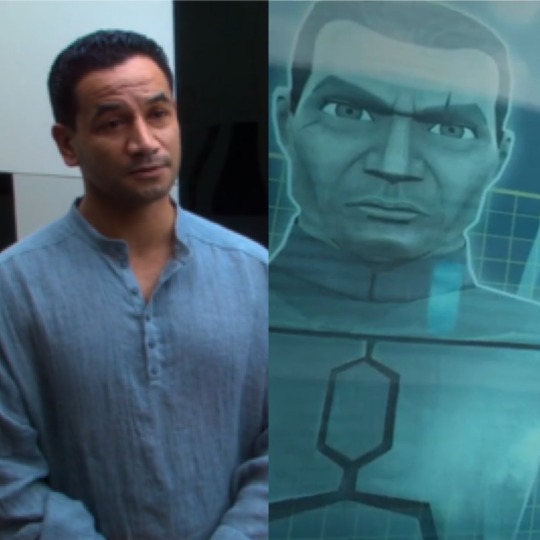
I did eventually get into the show later and (of course) got invested in the clones. Unfortunately, they were largely sidelined by the Jedi storylines. Out of the two new main characters created for TCW, Ahsoka definitely got more development and focus than Rex. When they announced The Bad Batch, I was excited to see a show specifically devoted to the clones… at least that’s what it said on the tin. We have all seen what lurks beneath those stylish helmets.
Jango Fett, you are NOT the father.
So who is?
Based on interviews with Filoni, it sounds like the Bad Batch was a George Lucas idea. And like all his ideas, it’s super derivative. The original trilogy directly lifted elements from sci fi serials, westerns, and samurai movies, more specifically Kurosawa films like The Hidden Fortress. For The Bad Batch character designs, the influence is obviously American action and adventure movies.
Now let’s get specific. Bad Batch, who’s your daddy?
Hunter
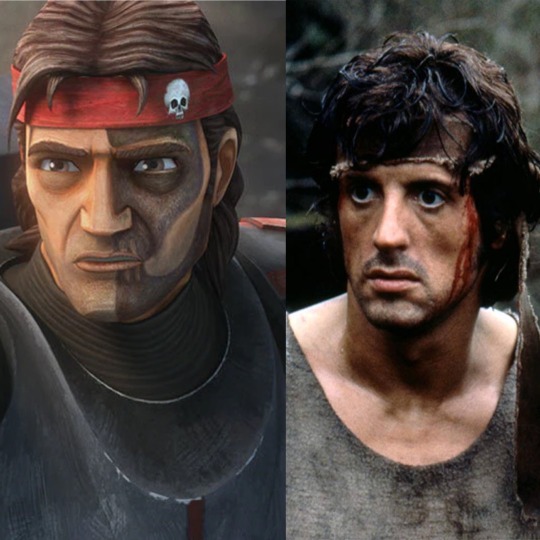
Sylvester Stallone as Rambo in First Blood 1982. That bandana has become an integral part of the iconic action hero look. You see a character wearing one and it’s a visual shorthand for either “this character is a tough guy” like Billy played by Sonny Landham in Predator 1987, or “this character thinks he is/wants to be a tough guy” like Brand played by Josh Brolin in The Goonies 1985 or Edward Frog played by Corey Feldman in The Lost Boys 1987.
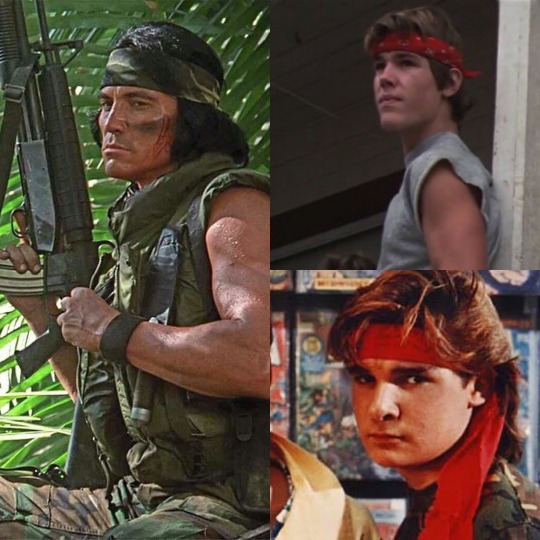
Hunter’s model is closest to the original clone base. If you look closely you will see the eyebrows are straighter with a much lower angle to the arch. His nose is also not the same shape as a standard clone like Rex, including a narrower bridge. It’s certainly not Temeura Morrison’s nose. Remember what I said about space Italians? It didn’t take much to push the existing clone design to resemble an specific Italian man instead of a specific Māori man. The 23&Me came back, and Hunter inherited more than the bandana from Sylvester.
Crosshair
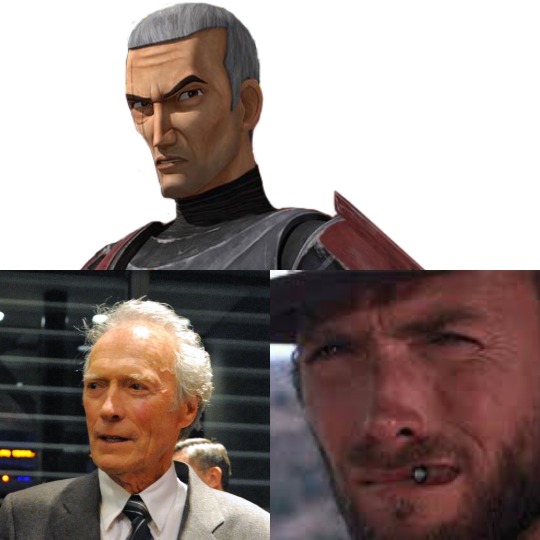
The long narrow nose, the sharp cheekbones, the scowl. That’s no clone, that’s just animated Clint Eastwood. Not even Young and Hot Clint Eastwood from Rawhide 1959-1965. With that hair, I’m talking Gran Torino 2008. The man of few words schtick and family friendly toothpick in lieu of cigar are pure Eastwood as The Man With No Name from Sergio Leone’s spaghetti westerns A Fist Full of Dollars 1964, For a Few Dollars More 1965, and The Good the Bad and the Ugly 1966.
In a way, this is full circle because the actor Jeremy Bulloch took inspiration from Clint Eastwood for his performance as Boba Fett in ESB.
Wrecker

In an interview Filoni lists the Hulk as an (obvious) inspiration for Wrecker. Ever seen the old Hulk tv show from 1978? Well take a look at the actor who played him, Lou Ferrigno. Would you look at that. Even has his papa’s nose.
You could make the argument that Wrecker was influenced by The Rock, an appropriately buff ‘n bald Polynesian (Samoan, not Maori) man. But look at him next his Fast and Furious costar Vin Diesel and tell me which one resembles Wrecker’s character model more.

Tech

Tech is a little trickier for me to place. If he has a more direct inspiration it must be something I haven’t seen. That said, his hairline is very Bruce Willis as John McClane in Die Hard 1988. His quippiness and large glasses remind me of Shane Black as Hawkins from Predator 1987. In terms of his face, he looks a but like the result of McClane and Hawkins deciding to settle down and start a family. Although, Tech’s biggest contributors are probably just everyone on TV Trope’s list for Smart People Wear Glasses.
And finally,
Echo

Oh Echo. Considering he wasn’t created for the Bad Batch, he probably wasn’t based on a particular character or movie. But if I had to guess, his situation and appearance remind me a lot of Alex Murphy played by Peter Weller in Robocop 1987. However, Robocop explored the Man or Machine Identity Crisis with more nuance, depth, and dignity. Yikes.
The exact tropes and references used in The Bad Batch have been done successfully with characters who aren’t even human. Gizmo from Gremlins 2: The New Batch 1990 had a brief stint with the Rambo bandana. I could have picked any number of characters for Defining Feature Is Glasses but here is the most cursed version of Simon of Alvin and the Chipmunks. Suffer as I have. Marc Antony with his beloved Pussyfoot from Looney Tunes has the same tough guy with a soft center vibe as Wrecker and his Lula (also a kind of cat). Hell, in the same show we have Cad Bane sharing Cowboy Clint Eastwood with Crosshair. I actually think Bane makes a better Eastwood which is wild considering Crosshair has Eastwood’s entire face and Bane is blue.
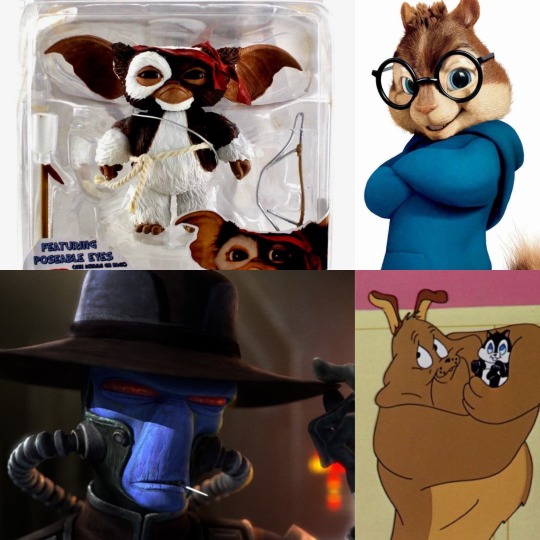
So we’ve established you don’t need your characters to look exactly like their inspirations to match their vibe. So why go through the trouble and cost of creating completely new character designs instead of recycling and altering assets they already had on hand? Just slap on a bandana, toothpick, goggles, and make Wrecker bigger than the others while he does a Hulk pose and you’re done. Based on the general reaction to Howzer it would have been a low effort slam dunk crowd pleaser.
But they didn’t do that.
So here’s the thing. I like the tropes used in The Bad Batch. I am a fan of action adventure movies from the 80s-90s, the sillier the better. I am part of the Bad Batch’s target audience. Considering what I know about Disney and Lucasfilm, I went in with low expectations. I genuinely don’t hate the idea of seeing references to these actors and media in The Bad Batch. I don’t think basing these characters on tropes was a bad idea. If anything it’s a solid starting point for building the characters.
The trouble is nothing got built on the foundation. The plot is directionless, the pacing is wacky, and the characters have nearly no emotional depth or defining character arcs. They just sort of exist without reacting much while the story happens around them. But I can excuse all of that. You don’t stay a fan of Star Wars as long as I have not being able to cherrypick and fill in the gaps. This show has a deeper issue that shouldn’t be ignored.
Why do the animated clones bear at best only a passing resemblance to their live action actor? In interviews, Filoni wouldn’t shut up but the technological advancements in the animation for season 7. So if they are updating things, why not try to make the clones a closer match to their source material? Why did they have to look like completely different people in The Bad Batch to be “unique”? Looking like Temeura Morrison would have no bearing on their special abilities and TCW proved you can have identical looking characters and still have them be distinct. In fact, that’s a powerful theme and the source of tragedy for the clones’ narrative overall.
Here’s Filoni’s early concept art of Crosshair, Wrecker, Tech, and Hunter. (Interesting but irrelevant: Wrecker seems to have a cog tattoo similar to Jesse’s instead of a scar. Wouldn’t it have been funny if they kept that so when they met in season 7 one if them could say something like “Hey we’re twins!” That’s a little clone humor. Just for you guys 😘)
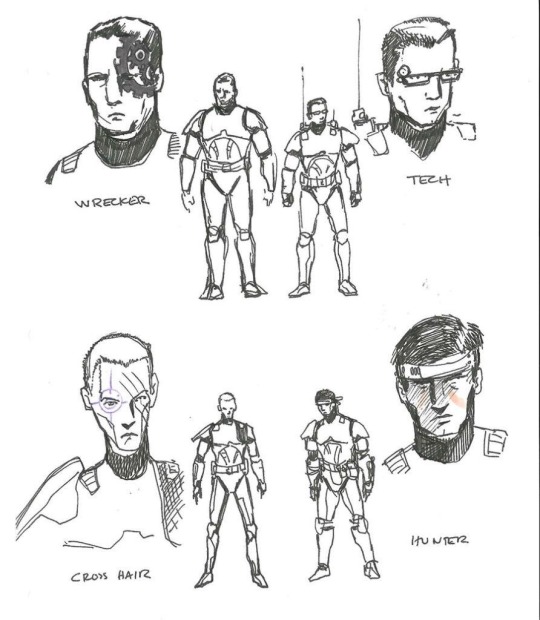
None of these drawings look like the clones in TCW, much less Temeura Morrison. Let’s be generous. Maybe Filoni struggles with drawing a real person’s likeness, as many people do. But he had to hand this off to other artists down the line whose job specifically involves making a stylized character resemble their actor. Yet the final designs missed the mark almost as much as this initial concept. Starting to seem as if the clones looking more like Temeura Morrison was never even on the table. It wasn’t a lack of creativity, skill or technical limitations on the part of the creative team. I don’t think there is an innocent explanation. They went out of their way to make the final product exactly how we got it.
This goes beyond homage. They could have made the same pop culture references and character tropes without completely stripping Temeura Morrison from the role he originated. It was a very purposeful choice to replace him with more immediately familiar actors from established franchises and films. It wouldn’t shock me if Filoni, Lucas, and anyone else calling the shots didn’t even think hard or care enough about the decision to immediately recognize a problem. And I don’t think they believed anyone else would either. At least no one whose opinion they cared about. Those faces are comfortingly familiar and proven bankable. They are what we’re all used to seeing after all. They’re white.
Lack of imagination, bad intentions, or simple ignorance doesn’t really matter in the end. The result is the same. Call it what it is. They replaced a man of color with a bunch of white guys. That’s by the book garden variety run of the mill whitewashing. There’s no debate worth having about it. For a fanbase that loves to nitpick things like whether or not it’s in character for Han to shoot first or Jeans Guy in the Mandalorian, we sure are quick to find excuses for clones who look nothing like their template. Why is that? If you don’t see the problem, congratulations. Your ass is showing. Pull your jeans up.
259 notes
·
View notes
Text
History of Chinese standing collars (part 3: post republican era)
Quick recap: I was debating with myself whether “Mandarin collar” should be a thing because standing collars throughout Chinese history looked different. I went through the Ming and Qing dynasties in part 1 and the republican era in part 2, now I’ll look at what comes after that. I numbered the styles in parts 1 and 2 but they’re only guidelines so you don’t have to remember anything.
So in this post we’ve kind of reached the end of the era where fashion consisted of a single silhouette in any given year and all hell ran loose. I’m having a lot of difficulties classifying things as Chinese or Western because the distinction is really blurred, and I also ran into problems explaining why certain historical European things looked so similar to Chinese ones so there will also be a lot of confusion.
1950s & 60s Chinese application
Summary of 1950s fashion, mainland and others.
Because of the communist victory in the Civil War, fashion in the mainland was different to other (capitalist) areas populated by the Chinese diaspora such as Hong Kong, Macau, Taiwan etc.. Let’s look at capitalist area fashion first; I’ll be referring to Hong Kong because Hong Kong was the center of cheongsam making at the time.
Collars on 50s Hong Kong cheongsam grew taller on the basis of collar style 10 but retained the rounded, tapering edge, resulting in a v shape gap down the middle that weirdly recalls collar style 6 from part 1 and part 2. It’s basically completely identical to collar style 6 but stiffened and extremely form fitting. It’s usually closed with one pankou at the base but because of westernization, 50s cheongsam often had no visible pankou----everything is closed with snap buttons, zippers or hooks and eyes/bars. An important aspect of collars of 50s and 60s Hong Kong cheongsam is that they left out the binding around the neck. All cheongsam prior to this point were bound around the exterior edge, the side closure, the slits and the collar seam (on the bodice not the collar), 50s cheongsam collars purposefully neglected the binding at the collar seam for some reasons. This makes the collar look like it’s one continuous piece of fabric with the bodice, which it isn’t. A lot of modern representation of cheongsam or any Chinese inspired clothing (in video games, books and anime etc.) do this, even if the character is from before the 1950s. It REALLY bugs me. If you are an artist or writer and designing costumes for Chinese characters prior to the 50s, please include binding/trimmings on all three seams, it’s an easy way to bump up historical accuracy. With that said, completely plain collars without any binding or trim was actually the most common. Let’s call this collar style 13.
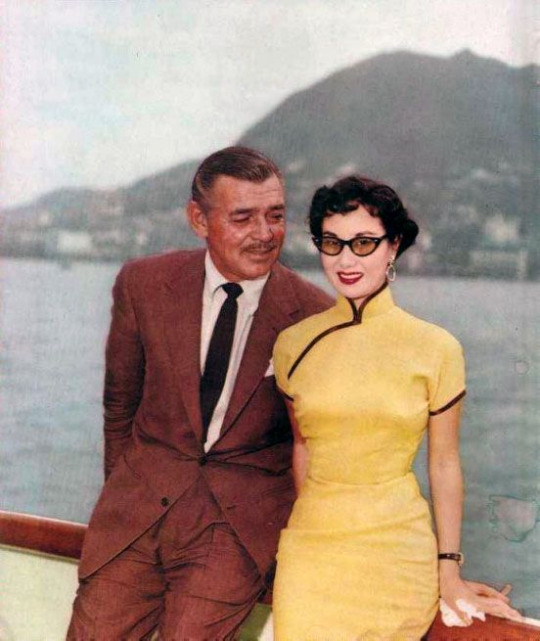
Source here
1954 photograph of Li Lihua and Clark Gable. Collar style 13 with stiffening and no collar seam binding. You can see how firm and neck hugging the collar is, contrary to a lot of modern cheongsam collars which are saggy and loose.
The popularity of collar style 13 continued into the 60s. When the cheongsam fell out of popularity, it ceased to exist as well.
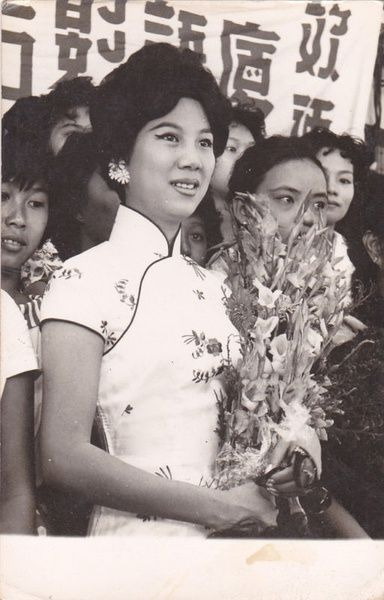
Source here
60s cheongsam with collar style 13. I’m really not a fan of the nude/light lipstick trend of the 60s, like, as a person with no lip color definition it makes me look like a potato.
Now moving on to mainland collars. In the 1950s, cheongsam with the 40s collar style 12 were still occasionally seen, but the fashionable collar shape also became taller and was similar to the Hong Kong collar style 13. Interestingly, some 50s mainland cheongsam retained the binding around the collar seam, making them look more “traditional” in a sense. However, collars both with and without collar seam binding existed and it was just a matter of personal preference.
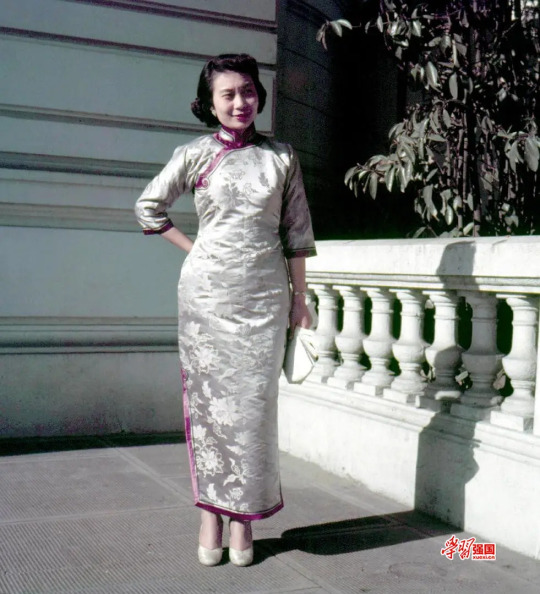
Source here
1950s photograph of a mainland lady in cheongsam. The collar is taller and closes with one button, much like Hong Kong collars of the era, but the neck binding is present.
Aoku robe collars from the 1940s onward mostly had the 40s style low collar, although in the 50s and 60s they rose in height very slightly.

Source here
1964 poster showing a girl in aoku, the robe has a low, rounded collar.
However, garments with a standing collar became worn a lot less frequently in the 50s and 60s in both mainland and non-mainland areas, since a lot of people adopted Western fashion.
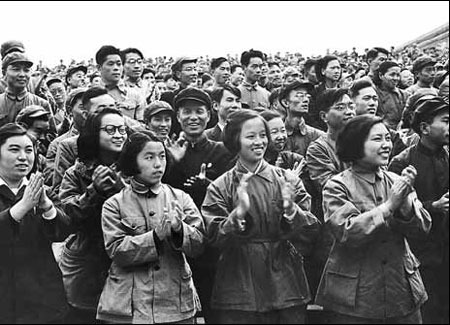
Source here
1950s photograph of a group of mainland people wearing jackets of Western construction. Some of them seem to be wearing informal military jackets, commonly known as “Mao suit” or “Zhongshan suit” nowadays, with folded collars.
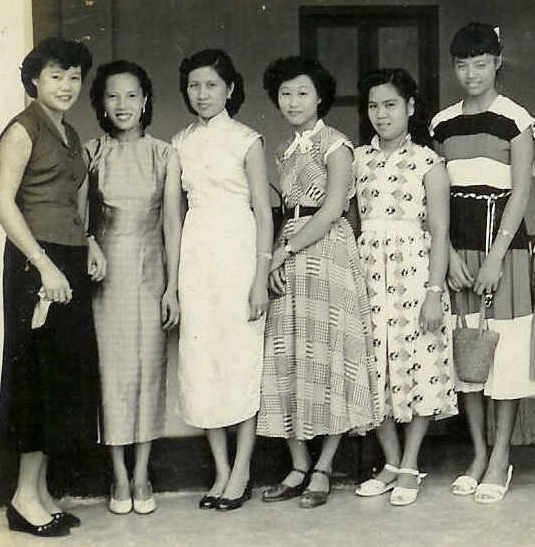
Source here
1950s photograph of some women in Malaysia, some in cheongsam and some in Western New Look dresses.
Western application
I think it’s also quite important to discuss how Chinese standing collars were perceived by Western designers, because the Western fashion industry does hold a lot more power globally and also reverse influenced Chinese collar designs in the post 1960s era. So, in the 1950s and 60s Western designers thought cheongsam was really cool and produced a lot of affordable sewing patterns for their versions of cheongsam. I think this is also because pre-1950s cheongsam didn’t use the Western construction method and patterns needed to be individually drafted so it was difficult to make mass produced sewing patterns. From all the sewing patterns I have seen personally, the super tall standing collar popular in Hong Kong was not really appreciated by Western designers at all?? Western cheongsam sewing patterns all had the very low 1940s style collar, combined with an hourglass silhouette New Look bodice and skirt, looking rather anachronistic. These collars also didn’t have binding/trim around the collar seam, in line with fashionable Hong Kong cheongsam of the day.

Source here
1950s Advance sewing pattern for cheongsam. The collar is low and has rectangular edges, something about a decade out of fashion in Hong Kong and Shanghai. No collar seam binding.
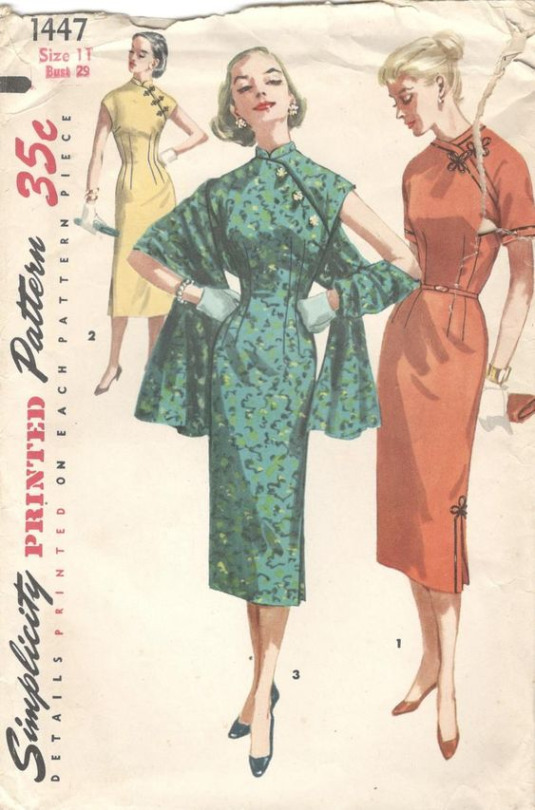
Source here
1950s Simplicity sewing pattern for cheongsam. Likewise with super low 1940s collars. Collarless cheongsam died in China in the mid 1920s, yet it lives on in the imagination of Western designers. By the way, the frog closures with a quatrefoil shape are not Chinese, I’m gonna write another post about this. I love the look in the middle it’s very glam.
1970s and later
The post 1960s era is what ultimately created the confusion around standing collars nowadays. Around this time Western and Chinese fashions started to merge and become one, and garments made completely in the historical Chinese method were more and more difficult to come by; Western construction techniques reigned supreme.
From the 70s onward, most “Chinese collars” had the 40s rounded edge shape but were either medium low or medium height. The lack of collar seam binding persisted into the current day, which is something I kind of lament because without this binding collars easily read as Renaissance doublet... (more on that later)
I usually avoid calling any standing collars from the 1970s onward Chinese/Mandarin because 1) standing collars were never a uniquely Chinese thing to begin with 2) since cheongsam was no longer fashionable among actual Chinese people, designers who made cheongsam pulled all kinds of shenanigans without any historical precedent whatsoever. Also, since clothes with structured/stiffened standing collars stopped being a staple in the average Western person’s wardrobe, white people started calling everything with the most remote hint of a standing collar Chinese to further stir the pot, emboldened by the cultural appropriation craze of the 60s and 70s. Ok that’s very loaded, but it’s true that in the 60s and 70s there was a lot of Western clothing designs that took inspiration from other cultures without permission. Westerners could totally design and wear Chinese style clothing given that the intention is respectful and they know about the garment in question, but a lot of times the accuracy of the designs leaves much to be desired. There was also a lot of Orientalist inspiration in the 10s and 20s but the borrowing back then wasn’t so... literal. When I look at so called cheongsam sewing patterns from the 70s onward, I sometimes seriously have trouble identifying if something is meant to be Chinese, Vietnamese, Japanese, Polynesian or any other region/culture...
I’ll just find pictures of Chinese inspired clothing from the 70s onward with a “Mandarin collar” label and point out their source of inspiration.
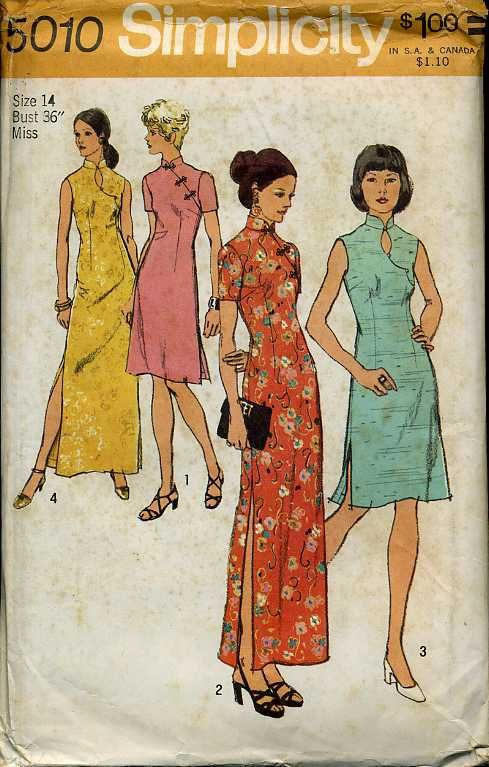
Source here
1972 Simplicity sewing pattern for cheongsam. It’s the same Western collar from the 50s and 60s just slightly taller. Oh and the closures used on the two designs in the middle are again likely not pankou. After the 60s, this neck design with a oval shape keyhole cutout became quite common and that persisted to the current day. Don’t know what the purpose of that was, just because you show 5 square centimeters more skin doesn’t mean your cheongsam is sexier?
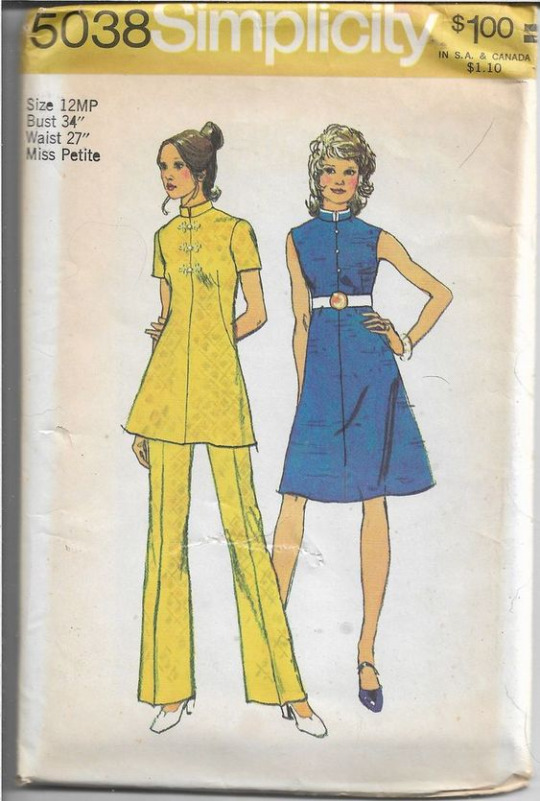
Source here
The description of this 70s Simplicity pattern says “Mandarin collar” but the source of inspiration is obviously Japanese military/school uniforms, AGAIN. The collar’s height and rectangular edges, combined with the placement of buttons above the waist on the bodice, everything about this reads as Japanese. The frog closures on the left are once again European and not Chinese pankou (sheesh I really need to make this other post). The original designer probably meant for it to be Japanese but the seller mistakenly labelled it a Mandarin collar design.
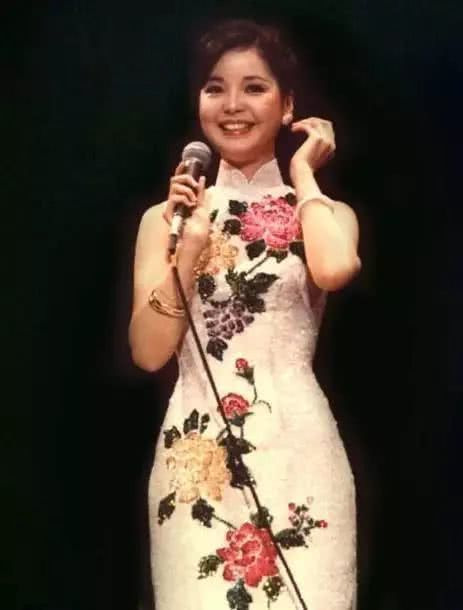
Source here
70s Teresa Teng (rest in power legend) in a theatrical cheongsam with a similar collar, either a stretched version of the 40s collar or a shrunk version of the 50s/60s one.

Source here
Google search result for “Mandarin collar dress”. Same Western low collar from the 70s. A new problem with modern mass produced cheongsam is that the collar oftentimes doesn’t fit the wearer and appears too baggy. Or maybe it’s not mass production, just that people nowadays are very unaccustomed to wearing tight fitting standing collars so they assume there needs to be some extra space? As someone who wears stiff standing collars on a regular basis I have to say it actually isn’t uncomfortable at all and elongates your neck a lot better. This is what most cheongsam collars nowadays look like, even the self proclaimed “traditional” ones, they literally originated from 1950s/60s Western sewing pattern companies’ interpretation of contemporary Chinese cheongsam collars.

Source here
Baidu search result for “Mandarin collar suit”. This, is, literally, almost a replica Japanese uniform. The seller is also using the tag Zhongshan suit lmao (I’ve explained in my 1950s mainland post what a Zhongshan suit is not supposed to look like), delusion is not a fragrance I guess. Why is it so hard to let Japan be Japan and China be China??
Conclusion & afterthought
Another thing I need to mention is that standing collars are by no means unique to Chinese historical dress; they were also widely used in European historical fashion, long before standing collars became worn with uniforms of “Mandarins” or Chinese officials, which further proves my point that “Mandarin collar” is not a valid term. Also, standing collars in Europe have always been stiffened/structured, whereas Chinese collars only started to become stiffened around the 1890s, possibly due to European influence as well. For example, the 1950s collar with rounded edges and no collar seam binding reads as European Renaissance doublet very easily. To be fair though, a lot of the collar shapes seen in early 20th century Chinese womenswear had been done before in European Renaissance fashion and during that time period in China only the OG Ming Dynasty collar mentioned in part 1 was used sooooooo
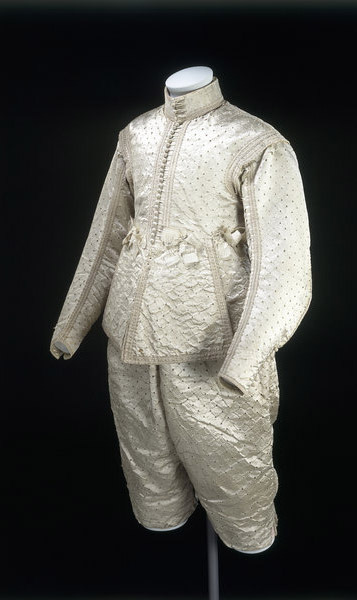
Source here
1630-40 English doublet. The collar looks mighty similar to 1930s Chinese women’s ones. I know next to nothing about Renaissance fashion so I’m not sure how it’s constructed, but it proves the point that collars like these were not a uniquely Chinese phenomenon.
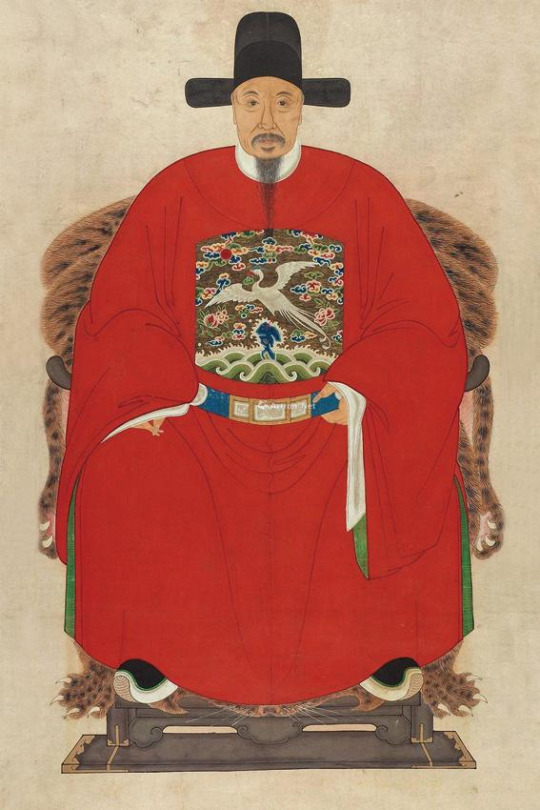
Source here
Meanwhile the Mandarins in China. He’s wearing a crossover collar robe underneath a round collar robe, no standing collar here.
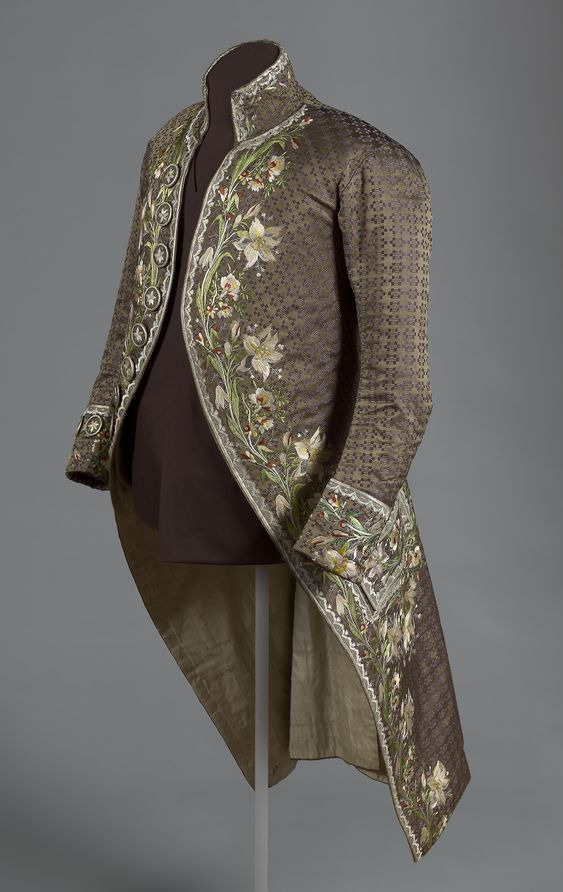
Source here
1780s French men’s coat with a standing collar.
Standing collars were also commonly used in Victorian and Edwardian women’s everyday fashion without any connection to China whatsoever.
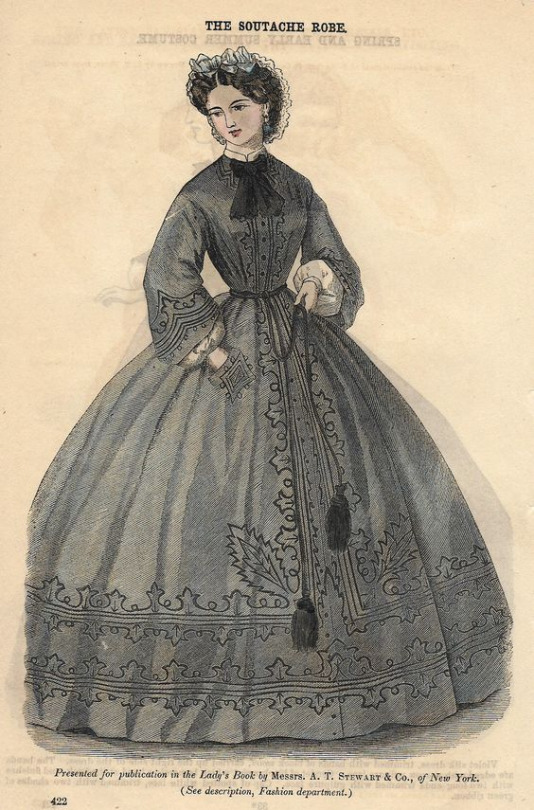
Source here
1860s fashion plate for a gown with a low standing shirt collar peeking underneath.
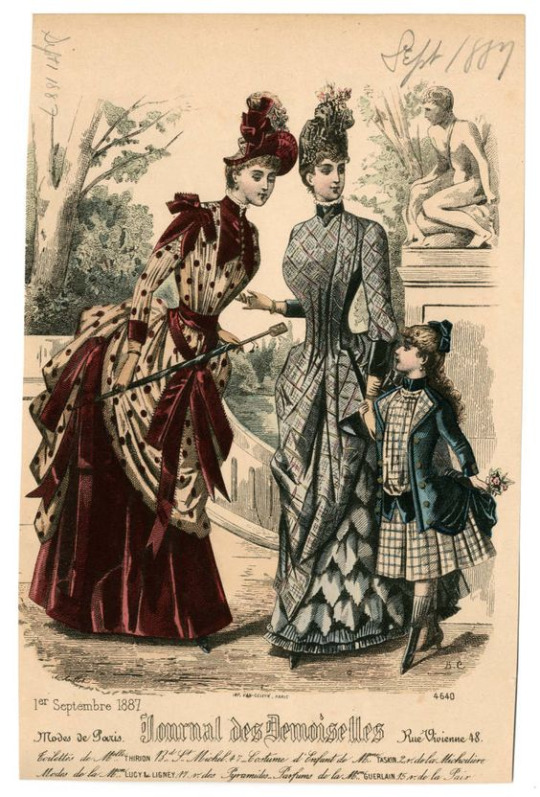
Source here
1887 fashion plate from the Journal des Demoiselles. Bustle gowns with standing collars.
Bonus rant
I have come to the actual point of this series of posts, to answer the question: should “Mandarin collar” be a thing? In which case I’m gonna have to go with no. In the three posts I made on the topic I categorized a total of 13 collar styles, each distinct from each other and some being inspired by Western clothing, and showed that the use of the term “Mandarin collar” nowadays is very vague and ambiguous. I don’t understand why people in the fashion industry give my ancestors all the credits for a design feature as basic and common as a standing collar... Maybe it’s a marketing gimmick like how Sternhalma (a German board game) is advertised in the US as “Chinese checkers”?? Or maybe it shows that a lot of fashion designers lack a basic understanding of historical fashion? Either way it makes no sense. I think the concept is also slightly offensive since it simply ignores the diversity of actual historical Chinese standing collar designs, kind of reinforcing the racist stereotype that non-white fashion histories are static and never changing.
If I do have to pick a most traditional/iconic style of Chinese standing collar, I would go with either the original Ming Dynasty soft collar with metal buttons or the 1940s short collar with collar seam binding used on aoku, cheongsam, changshan and magua. In the mainland Chinese countryside, the 1940s style collar was preserved and actually still made today, but in the post-Mao era it became increasingly seen by the mainland population as 土 (a derogatory term for Chinese folk stuff meaning tacky or cringy) compared to the exciting new Western fashions being imported at the time. As a result, more traditional items of clothing like aoku for women, changshan and magua for men were neglected in favor of more westernized cheongsam designs, leading to some cursed contraptions.
Maybe this is a hot take, I personally really don’t vibe with the concept of 土 because it’s very loaded and usually the gateway drug to massive internalized racism. I’ve heard so many people bash aoku and magua constructed in the historical method and put post-60s Western inspired cheongsam on a pedestal even though the former is grounded in history and the latter is an Orientalist mess. There is nothing wrong with making aoqun, aoku, magua, changshan, cheongsam or any other historical item of clothing in the historically accurate method, they’re charming in their own ways and don’t need to be “modified”. In my opinion, the puckering under the armpits caused by the lack of a shoulder seam and the rounded shoulders are what makes historical Chinese clothing beautiful to begin with :3 I think there’s something inherently modern and authentic in the pedantic, antiquarian pursuit of historical clothing, like you know how whenever a revival happens it actually brings something new to the table? It’s not problematic to wear modern cheongsam designs per se, it’s just important to keep in mind that it doesn’t have much to do with actual Chinese history and represents more of the status quo of Chinese fashion nowadays.
Ok I’m going off the collar track but it’s time to finish this post. Thank you for reading, and as I mentioned, the next post will be about Chinese pankou. I’m almost finished with that one as well and I’m really excited with what I have planned next :D
199 notes
·
View notes
Note
Hey, what do you make of Peter following Gwen around after their breakup in TASM2?
Okay, this is a tough one because, like, I don't want to be like, yay stalking, but like, in the specific context of this scene, I'm gonna be a little bit like that. Not real life stalking, before someone comes into my inbox like, "Traincat, are you glorifying stalking?" I'm not! I've been followed for multiple blocks in NYC on several different occasions so believe me I know this behavior, in real life, is not excusable. But we're talking about a fictional character in a movie so I think it depends on what we mean when you say what do I make of it. I'm going to be talking about it purely in terms of how I'm judging most Spider-Man adaptations, which is on a scale of how true I feel they are to the original comics, not on a 1:1 adaptation ratio but on whether or not I feel they captured they spirit of the series, setting, and character.
So I have to say that I think it's a good scene because I think it's ultimately very in character for Peter. I also think it's an interesting scene because while the films are primarily through Peter's perspective -- we know his intentions while he's following Gwen around are benevolent, if overbearing -- it also allows the audience enough room to step back and to see that he's a flawed character. Which I think is one of the problems some Spider-Man fans have with The Amazing Spider-Man series: it presents Peter as a flawed hero. Prime example? He's kind of stalking his ex-girlfriend.
Do I think this is objectively great behavior from anyone? No, and I don't think we're necessarily supposed to approve of his actions. I really don't think TASM's goal was to make us agree with everything Peter does. On the other hand, do I think it is in fact hugely in character for Peter? Listen. Peter Parker's a little bit of a stalker.

(Daily Bugle #2)

(ASM Annual #42)
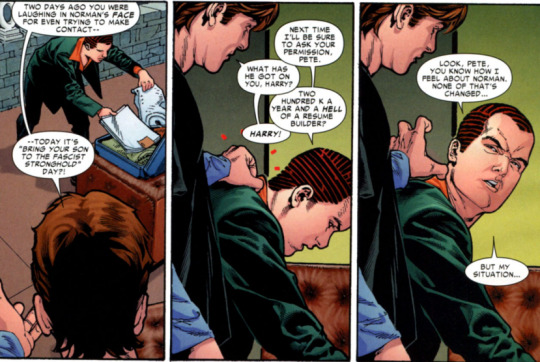
(ASM #596)
Don't bug your friends and family. I mean, unless your friends and family are constantly being kidnapped by supervillains. Then I guess it's like "find my iPhone."
One of the things I've talked about with Peter in terms of how he's a flawed character -- and I very much think that he is and that that's a good thing -- is that he can be controlling. It's the flipside of the responsibility: because Peter has more power than other people in his life, he assumes responsibility for them, whether they like it or not. This is, from an objective point of view, some real machismo bullshit, but with a fictional character as well-developed as Spider-Man, I think it's an interesting character note that leads to potentially interesting friction between him and his supporting cast. TASM's Peter follows this same general path; although I don't think he's a 1:1 adaptation of 616 Peter, I would say he's essentially assembled of all the same parts. And that includes his tendency to make decisions for other people.
I've seen the bit where he's following Gwen brought up a lot, and I'm not saying it shouldn't be, but what I find interesting is that Peter's behavior immediately before it in the movie is almost never dissected in the same way. When we pick up with him at the beginning of the movie, he is controlling towards Gwen. We know in the gap between The Amazing Spider-Man and The Amazing Spider-Man 2 that they've had an on and off again relationship, with several breakups -- all, it's implied, facilitated by him, because he feels guilty over her father's death and George Stacy's last words, which asked him to promise to leave Gwen alone. (I have a different post about how it's interesting that the audience seems to side with Peter and agree that he should listen to George's desires for him to leave Gwen alone instead of Gwen's desires for Peter to be with her here, but it's a little off topic for this particular discussion.) This follows the ending of the first movie, where Peter breaks up with Gwen and then appears to get back together with her at the last moment. It's all Peter's decision, on his own, made largely if not entirely without Gwen's input. He certainly knows her feelings, it's just that they don't actually factor into his decision making when we pick up at the beginning of the movie. And that's a bad thing and I don't think, at least from my perspective, the audience is supposed to agree with him -- not because they want Peter and Gwen to be together, either, but because Peter is in the wrong.
Which is why I think the "I break up with you" scene is really interesting -- from the way Peter continually talks over Gwen -- his loudly going "wait, WAIT" over her while she's trying to express her side -- to the way Gwen wrests back control by breaking up with him and that breakup sticking for the majority of the movie. Which leads us into the montage scene where Peter's swinging around New York, including the clip where he's following Gwen from the rooftops. The viewer knows why he's doing it -- because he wants to make sure she's safe, but also because he wants to be able to see her on his own terms, without letting her have that control. The flipside of great responsibility is great control issues.
I'm going to say something potentially controversial, but I think some of the pushback against The Amazing Spider-Man franchise is that they're Girl Movies. They're the chick flicks of the superhero set. Look at the set up of the first kiss compared to Raimi's Spider-Man -- he doesn't shed his shy public persona to manfully rescue the damsel in distress from thugs while the rain pours down around them and she isn't so overcome that she has to kiss him upside down. (Look, it's an iconic kiss scene! I value it for its contributions of the pop culture landscape! But the cold pouring rain does conveniently provide the audience with a little PG-13 Heroine Nipple Action.) Instead it happens on Gwen's rooftop after Peter gets done arguing with her dad about politics at The World's Most Awkward Family Dinner. If anyone gets a little PG-13 nipple action, it's Peter when he has to shuck his shirt so Gwen can tenderly wipe down his gross lizard sewer wounds while she wears a pristine white nightgown. I've mentioned before that I don't think "superhero" shouldn't really be viewed as a genre in and of itself when we're judging what makes a superhero movie "good" because most superhero films are action films mixed with another genre -- sci-fi, Western, war movies, and then there's The Amazing Spider-Man/2, which are romances. They're the Twilight of superhero films. That's why Andrew Garfield gets to have such great hair. And that's why they fall back on tropes like "the hero staring longingly at the love of his life from far away, knowing He Can Never Be With Her." Cue the music. And it works, because Spider-Man is, essentially, a romantic hero, with all the pros and cons that come with that. Is it problematic? I mean, yeah, if we're supposed to agree that Peter's in the right, which I would argue is debatable, even if Gwen, when they get back together, seems to get over him following her really quick. Romantic stalking is a well established trope -- and whether or not it should be or whether it glorifies abusive behavior is a related but different conversation to viewing this scene on its own, through my preferred lens of: does this scene belong in a Spider-Man movie?
Yeah, because, and I say this extremely lovingly, he sucks. If Peter is supposed to be a perfect character, then of course he shouldn't do this, and this scene shouldn't be in the movie. But he's not a perfect character -- he's a very flawed one, and it's an in character scene.
153 notes
·
View notes
Text
Another Sonic ramble
So once again I’m here with one of my rambles about my incredibly subjective view of how the Sonic series should be handled! *Beat*
...anyway.
So, one of the more recurring opinions on the fandom is that Sonic games should be written by Ian Flynn, I have talked before about the gripes I have with his writing and why I disagree with this but this post is not entirely about him, but rather a more general topic that has been bugging me for a long time.
The other day I was watching a video speculating about the upcoming Sonic Rangers, there’s not much to write home since it was pretty well made but there’s a particular part that inspired me to do this post and talk about it with other fans to discuss it.
See, at one point the video critisized the fact that Sonic Forces was written by a Japanese writer because they have to re-write the script in English and that can cause problems with localization, and that it would be better to have western writers from the get-go since Sonic’s main demographic comes from there, while making an off-hand suggestion that Ian Flynn could be a main choice. While I can see where they’re coming from, my response was a simple:
‘‘Absolutely, not’‘
See, I have a lot of issues with this to put it bluntly and I’ll try to break them down and explain them the best I can since they’re pretty subjective in nature, but I’m bringing this up because I want you guys to share your thoughts as well.
So, why does it bug me so much the idea of Sonic being handled by western creators?
In my case, the main reasons are because Sonic loses a core part of it’s appeal because of this, the fact that SEGA of Japan seems to have a better grasp of the franchise’s tone and characters and there’s the very subjective point that, in my eyes, American versions of Japanese franchises were always nothing more than dumbed down products of the source material.
To start with my first point, whenever someone talks about Sonic’s creation, a lot of people are quick to point out that our favorite blue hedgehog and his games were inspired by western pop culture and cartoons, and that is true, however oftenly they forget to mention a core thing that not only inspired, but also formed part of the core identity of this franchise.
Sonic is very inspired on anime, and at heart this franchise is a shonen.

(This image by The Great Lange expresses more clearly what I mean)
Generally, the most acknowledgement anime gets on it’s hand on Sonic is the mentions of Sonic being inspired by Dragon Ball, particularly the Super Saiyan, but there’s so much more than that, as Sonic blatantly takes inspiration from Studio Ghibli films specially in games like Sonic 3, which draws a lot of inspiration from Laputa: Castle in the Sky, this great post shows proof that this is not a coincidence.
And it doesn’t stop there, Shiro Maekawa himself has stated that SA2′s story (and in particular, the characters of Shadow and Maria) draw a lot of inspiration from the manga Please Save My Earth.
Even Sonic’s character design resembles shonen protagonists moreso than the main characters of silent cartoons, don’t believe me?
Sure, Sonic has a cartoony anatomy, no one can deny that, but he also exhibits a lot of traits from shonen characters such as spiky hair/quills (?), dynamic posing, a confident, courageous and energetic personality and most importantly, fighting spirit.


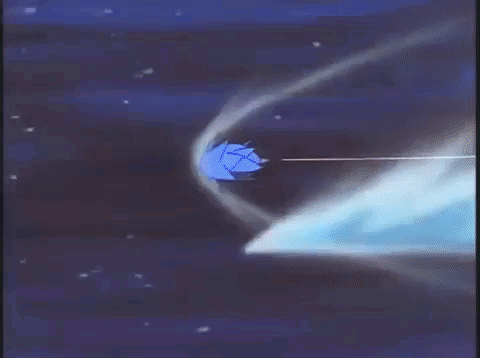
If you compare Sonic’s personality and more specifically, his abilities and moves to, say, cartoon speedy characters like the Road Runner, there’s a pretty big disconnection between him and western cartoon characters. Hell, this disconnection is even just as present if you compare him with a character like The Flash from DC.
Simply put, Sonic acts, moves and more importantly, fights like a shonen anime character. He doesn’t just go Super Saiyan and that’s it. Here’s even a quick comparison if necessary.
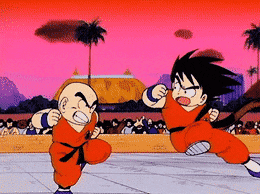
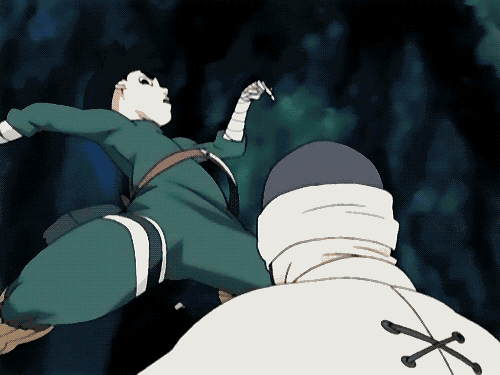
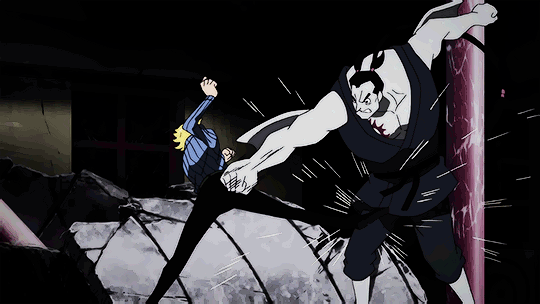
And this is important because this doesn’t apply just to him, but the whole franchise as a whole and when it takes a more western approach, all of these details are kinda lost or more downplayed, of course this depends on the artists and there’s YMMV at hand, but I think my point is clear.
My second point is...SoJ has consistently proven they have a much clearer grasp on how Sonic’s world and characters are compared to SoA.
Hear me out, yes, Sonic 06 and ShtH exist and yes, SoJ is not perfect by any means. But hear me out...when did the characters start to get flanderized and turned into parodies of themselves? In the 2010s...and when did SEGA move from Japanese to western writers in the games?
Of course it was more then that since there’s a whole tone shift that came with this decade and the new writers, but it’s not a coincidence that when writing in Sonic started to decay, western writers also happened to get on board with the games.
Besides that, SoA has a wide history of not getting Sonic’s tone and characters, from how they made media without much of Sonic Team’s input, to altering how characters are seen in the west. (Such as how they amped up Sonic’s attitude in their media or how the English scripts of the games featured things like Sonic seemingly barely tolerating Amy while the JP scripts portrayed this as Sonic just not understanding girls all that well instead, or for more recent examples, the addition of the ‘’torture’’ line in Forces). Not only that, but even ignoring obvious infamous writers like Ken Penders, even the ‘’best’’ writers from the western side of Sonic are still not above of giving us Pontaff-esque gems.
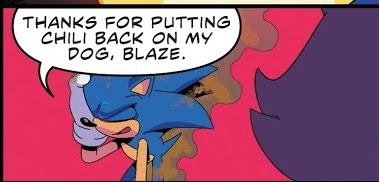
Like this one.
Or alternatively, I feel like sometimes western writers on Sonic rely a bit too much on their personal vision about Sonic which may or may not be a good thing, clear examples of this are Ian Flynn himself and Pontaff.
By contrast, while SoJ has it’s own share of notorious inconsistencies when dealing with writing (The 2000s era is a big offender), it seems that for them Sonic hasn’t changed much and this is visible not only on the JP scripts of the Modern games which are for the most part better than the ENG ones, but also things like the Sonic Channel comics and the recent one-shots they made with Sonic interacting with the cast show that for all intents and purposes, the Japanese’s staff vision of Sonic is much more clear and consistent compared to the west. Because of this, I’d rather have a good Japanese writer on Sonic games with the localization being focused on being faithful with the original script than have a more western writers dramatically changing the characters. (I don’t mention the tone since either way, SEGA is the one in charge of that and the writers have to follow that)
My last and very subjective point is that, at least for me, everything SoA does with Sonic involving the writing and canon feels like a dumbed down version of the source material. One of the reasons it bugs me so much that in the latest decade Sonic has taken a more western direction is because a lot of what I pointed out gets lost as a result, even if some of those elements are still there, you can tell they’re more downplayed with products like the Tyson Hesse shorts having a more predominant cartoon direction. If any of you have been following my blog for a long time, you should be aware that just because I prefer the Japanese Sonic content doesn’t mean I won’t give the western products a chance, my enjoyment for Mania, the Tyson Hesse shorts and the movie should be a testament of that, but at the same time I can’t help but being sour about the fact that because of these products, we don’t have stuff like a new anime for Sonic or even a serialized ‘’main’’ manga as an alternative for the comics, and my hype for these products is generally more subdued as a result since I’d wish SEGA rather spent that money and resources on more Japanese content than just merchandise.
In particular, because Sonic is a Japanese franchise with a notorious inspiration from anime, what I get from this is a pretty big contradiction. I know Sonic is much more popular on the west but...is it really necessary for his game or products to be handled by western creators to keep their appeal?
For instance, imagine if Dragon Ball’s manga and anime got replaced by western comics and animated series because of it’s world-wide appeal, would that really be the same?
Or imagine the same thing with Fullmetal Alchemist, a pretty aclaimed anime that has a lot of western influence. Would it really not matter at all if it’s Japanese products were replaced with western ones?
At least for me, it wouldn’t.
And what I said about American versions of Japanese franchises being nothing more than watered down versions of the source material? I have that view because of countless examples.
Mega Man and how the English manuals removed a lot of important information about the story of the Blue Bomber’s game and world, causing a lot of plot holes in the process.
American remakes like Godzilla 1998 or Dragon Ball Evolution being an in-name only version of the source material.
Or the many censored anime English dubs from the 2000s, for instance, whenever I see the Yu-Gi-Oh! dubs, I only see a very dumbed down and childish version of a show that was originally a shonen.
And I know that all of these things don’t have to necessarely get lost since every creator is different and there’s franchises like Avatar which are made on the west but draw a lot of inspiration from anime and I’m aware of that, and I want to make it clear that I’m not trying to say that American writers are not allowed to work on Sonic, what I’m trying to say is that inevitably there’s always gonna be some culture dissonance and clash when writers from another culture handle a foreign franchise. And even with examples like ATLA, I think being made by one culture while being inspired by the other is actually a big part of these franchises appeal and it’s something that can’t simply be replicated by handing it to creators from that specific culture they draw inspiration from.
I think James Rolfe’s quote about the same thing with the Godzilla franchise sums up how I feel about this.
‘‘It’s like champagne, anybody can make their own and call it champagne, but unless it’s from Champagne France, it’s not real champagne’‘
So, this last part was very subjective, but I think this post in general sums up why I dislike so much the idea of Sonic having western writers specifically in the games or just focusing more on that side in general.
But what do you guys think? I guess I am too biased so that’s why I wanted to ask for opinions and discuss this topic.
27 notes
·
View notes
Text
9/13/2022 DAB Chronological Transcription
Joel 1 - 3
Welcome to the Daily Audio Bible Chronological, I'm China. Today is the 13th day of September, welcome. It is so great to be here with you today. Today we are in the book of Joel. We are in chapters one through three. And this week we are in the New International Version for this week.
Commentary
So we jump into the Book of Joel today, and we read about an invasion of locust and really a famine taking place. Now, personally, I'm like, do locust? Is that still a bug that we have to worry about? Is like, a locust of modern day cicada? Or like a termite? What does a locust look like? Okay, so now I actually feel quite silly because I just looked it up. I typed in locust, and it said swarming grasshoppers. So that is our modern day locust. It is grasshoppers. So I'm like, okay, I guess grasshoppers can eat. They can put down some crops. I've seen maybe one at a time. Like, I've never seen a group of them, so I can't imagine them swarming. I bet it would be loud and scary because they jump. I don't like things that jump. I'm like, no, stay on the ground. Be predictable. Don't jump around on me. And so to think of them being a swarm and eating everything that you have planted, that would be devastating, truly. Like, you're depending on your fields. You're depending on your crops to eat. You're depending on them either for your family or for trade. And then imagine locusts coming and eating everything that you have. Imagine having this beautiful garden and then going out one day, and it's gone, and you just see a bunch of grasshoppers everywhere. That sounds like a horror movie. That sounds like my kind of horror movie. Not what I would want to watch, my kind of horror movie, but, like, what would feel horrible and scary for me, that is what it would be like. And then there's a call to lamentation. And I saw something a while ago that I thought was really interesting. It was talking about how a lot of modern day worship songs right now are what I can get from God and how he benefits me and how I'm victorious. I don't think any of those things are wrong by any means. But it's also what the point of this post was saying was a lot of times in Scripture, the most beautiful parts of worship come out of lamentation and how it would be okay if artists or corporate church settings wanted to write songs about lamentations. And so that has kind of been circulating my brain and just being like, actually, I think there's a lot of beauty in it. And I think that's why we don't really see a whole lot of people lamenting is one, because I feel like we as a people in the Western culture, are very uncomfortable with emotion and emotion riding its course and being present for longer than 12 seconds, let alone grief. And whereas in the Eastern culture of the Middle East. Something that is sacred is like. Tear jars are a very popular thing to find in what is the word I'm looking for. Like. Antique shops in more like. Artifacts shops in Israel. Because it was a I don't want to say a monetary value. But like, a deep value for a woman who have collected her tears and to give them to her husband and say. This is basically the value that I have longed for you. And that's a lot of tears to have collected. And it's also just like the thought of crying, and you're like, Where's my jar? Let me fill this really quick. And so I say all that. There's one aspect that's, like, let me collect every emotion I have. And then there's our culture, who's seemingly very uncomfortable with emotion, and I can understand both sides. I am one person who can very much so be in lamentation and also another person who's, like, I don't know that this is safe to be, like, to explore this feeling in this moment right here. But again, I think that there's a time and place for everything. But we hear that there is a call to lamentation where it's talking about kind of a guess, like, what is normal or what is usual for lamentation is to put on Sacloth and to mourn and to wear ashes. And that's what's happening. And then it talks about an army of locusts. Now, there is an army. It's not just a swarm. There's an army of them. This is just where my brain goes. I know this is serious. This is a very serious reading. I take the word of the word serious. When I read an army of locusts, I just imagine grasshoppers with, like, little tiny swords and shields, but that's not what's happening. And then there's this calling back, like, rend your heart even now, declares the Lord, return to me with all your heart, with fasting and weeping and mourning. Really, that doesn't really need to be broken down. What that looks like to me or what that feels like is be true, be honest, be humble, be contrite in your heart positioning. Let it be real. Render your hearts and not your garments. Return to the Lord your God, for he is gracious and compassionate, slow to anger and abounding in love. And he relents from sending calamity. Who knows? He may turn and relent, like, what a beautiful place to be. And who knows, he may turn and relent. He may actually bring forth restoration. And so we continue on. And the Lord he's responding. He's replying. And he's like, yes, I will. I'll send you a new grain, new wine, olive oil, enough to satisfy you fully. Never again will I make you an object of scorn into the nations. And there's the day of the Lord and there's this prophesying that the Lord's spirit is going to be poured out over us and he's going to show wonders in the heavens and the earth, and we will see God, we will see who he is, and he will be revealed and the nations then will be judged, and then there is a blessing for God's people. And that's the book of Joel. And I think that it is honestly, it's really beautiful and it's really profound because it's three chapters and we also read The Heart of God very quickly, where it talks about it's almost like a summarizing of turning away from the Lord and reaping what you sow and healing the weight of those consequences, and then also being prepared to embrace a famine. And then the Lord saying, Come back, turn back to me. Who knows, maybe I will relent. Who knows, maybe I will restore. And I think that is such a beautiful place of hope for us all is who knows, maybe the Lord really will give us restoration.
Prayer
And so Father, I thank you that that is your heart for us, that when we turn away from the ways that we have chosen in our own paths, our own plans, that we're choosing our own strength, we're leaning on our own understanding, which you have instructed us not to do, to lean and trust on you. I thank you, God, that we find you when we seek you. And just like you have really spoken over this community this year to seek God, thank you that it's not a tease. You don't tease us and say, Come and find Me, but you won't. God, I thank you that we do find you. And if anything, when we steady ourselves, we realize that you've always been there, you've always been present and consistent. And it's up to us to really get quiet enough to silence other distractions or other things that would keep us from the stillness. And I thank you that who you are is simple and your gospel is true. I pray that we'd be people who are sensitive to your spirit and are always seeking you. We would stay in a place of seeking and Father, it is in Your name we pray, amen.
Outro
I don't know why, but that last part of scripture where it talks about or it's not really the last part, maybe in the middle, more towards the end, where it's talking about, who knows, maybe the Lord will relent, maybe there will be restoration. I feel like there's like a great invitation of hope in that. And I feel like that's really for some people today. And I don't know what your situation is. I could come up with a couple of different scenarios, but ultimately, if you are in a place that feels barren, that feels like the locusts have eaten everything that you've worked towards, turn towards the Lord, do not lean on your own understanding. Do not lean and be tempted to follow the things that feel like they will comfort you because they can't. Don't choose isolation because that's not what's better for you. Don't choose the spiraling thought processes that we're going to keep you in a place of depression or anxiety. I know that's hard. Like, I'm choosing my words carefully because I want to be gentle in that area because I know how intense that reality is. I could sit here and come up with a bunch of scenarios, but that's not always helpful and they're not always relatable. But if you feel like your harvest has been eaten by locust, turn towards the Lord. Who knows? Maybe he will restore who knows? Maybe he will come and bring new grain and new wine. I think he will. The other day I was kind of having this really bad morning and was just really afraid that some things were going on with health and I don't really have any reason to believe that those things were happening. It was just kind of this thought based on something that I thought was going to happen differently and literally just was like spiraling, well, what if this happens? Or what if this happens? And what if this is my reality? And I really just felt like I heard the Lord say, but what if you're whole? What if you're healthy? What if that doesn't happen? What if the opposite of that happens? And I just felt like the Lord was like, I want you to write from this place. And so I just started writing some things down in my head. I need to write them out, but I just even started to sing it around my house. What if I'm home? What if I'm healthy? What if my thyroid levels are in check? What if I'm not in this place that I think that I am in? And I just kind of kept going down the list and I just was in this place of hope, of like, even if the reality was none of those things were happening, it was just, oh gosh, what if this means this? And then what if that means this whole domino effect, which is also known as spiraling. I just like, what if it's the opposite? What if your thought process is wrong? What if you are old? What if you're healthy? What if that doesn't happen? And it very quickly just started shifting things for me and I was able to, one, take my thoughts captive and make them obedient to Christ. And I wasn't wondering and wandering in a place of what if in the bad aspects, it was more of what if those thoughts aren't true? What if my body really is whole? What if my body is really healed? What if I really believed that the gospel was true? What if and you just kind of keep going down those things? And anxiety seemed to really dissipate and my chest didn't feel as tight, and I didn't feel like my heart was racing and I felt at peace. And I also really felt like I was surrendering to the Lord and choosing that whatever he has authorized or ordained is good. Yes, hopefully that's encouraging to somebody. But what if the Lord turns and relents? What if he restores? I just encourage you next time that those thoughts and I'm not saying that they're not valid, because I'm sure that they hold validity. And would that be your past, to keep spiraling? Take it to the Lord and ask yourself what the Lord asks you. What if you were whole? What if he restores? That's the kind of the place that I would like to leave you in today, lead you into a moment to have some quiet time and some intimacy with the Lord.
1 note
·
View note
Note
So your museum posts just always make my day- I volunteer in my town and I’ve done classes in curation that make me just want to tear my hair out at some posts. I had to do so many projects on the complications and varieties of situations that arise with repatriation.
I also was looking online for lots of fabric and saw some lovely old dolls and thought of you. I also think of you when watching some mudlarks, who find doll heads and make jewelry or other art with them, always appreciating them even when a bit broken.
Yeah, some people just...don’t really get how complicated the museum world is. Repatriation is, of course, a good thing that needs to happen more, but it’s not as simple as just “take everything from another culture and give it back to that culture.” In ways that can get pretty Byzantine, and which I- as a local history museum tour guide -am not remotely qualified to explain.
What bugs me a lot is people who are like “all museums are full of stolen artifacts and should be shut down!!!!” Because there are museums for EVERYTHING.
There are farm equipment museums. There are duck decoy museums. There are shoe museums and Barbie museums and Elvis museums. I once had a coworker who used to work at the Yves Saint-Laurent museum. A lot of museums couldn’t have stolen artifacts even if they wanted to, simply by virtue of their themes. I work in local history, at places that make a point of having only things that were owned (when new) by New Englanders. And none of the sites I currently work at focus on indigenous people. As far as I know, the only things we have from non-western cultures were pieces specifically made for sale and export. To shut down all museums just because some have things they really need to give back makes no sense.
(It’s also a remarkably Eurocentric and America-centric attitude, because like...there are museums in other parts of the world. You know, those places where the repatriated artifacts would go once returned, if the parent culture wanted to display them?)
(On top of that, people seem to have some other weird ideas about museums. Like that whole Newport mansion robbery thing. Some people seemed to be reacting to that in a very “fuck billionaires do crime” way. Which like. Absolutely fuck billionaires, but those mansions...aren’t rich people’s houses anymore? They’re museums and the objects in them are on public display? For the vast non-billionaire majority of the world to enjoy, unlike when they were new?)
Anyway. Sorry. That got kind of long. I’m glad the dolls remind me of you, and I’m glad you like my blog. Thank you so much!
67 notes
·
View notes
Note
Hey, after this banner seeing Dimitri being associated with ‘evil’ characters didn’t feel really good. I am neurodivergent and when I voiced my complains about this I got completely silenced and suddenly fallen alts don’t represent any kind of “evilness”.
I don’t like to say this is ableist but it really feels like it. I wouldn’t have minded this alt if it was ina. new heroes banner for post ts units but the way it was featured, is just not it. It also feels like this alt completely destroys Dimitri’s arc.
I’m very... hmmm. It’s complicated. The more I think about his inclusion on this banner the less I like it.
I think, had Dimitri existed at the game’s inception or been on the first fallen banner ever, or even if we’d had more heroes like Dimitri on this banner or in between it wouldn’t bug me so much, but we have three years of precedent where the fallen units are possessed by evil forces or lose their minds in supernatural ways and to suddenly put Dimitri, a character that by all accounts in canon is simply mentally ill, on the banner... It hits wrong.
And I know. I know. I know it’s just a cash grab. I know they just put him here because he does technically fit the definition and they know he’ll sell. I know it probably wasn’t that deep, no one really thought about it that hard. And I know Japan has a very, very different culture surrounding mental illness than we do and part of this is just my western lens. And I’m hoping, genuinely hoping, that his Forging Bonds and dialogue will focus on his actions during the time skip, because that is what could make him a “fallen hero”, rather than his mental illness.
But like? No, it actually has some really ugly, unsettling implications, especially right now when we don’t have much to go on. I can’t point to a single, concrete action that would make me say “yes this is it, this is exactly why he belongs on this banner” because Three Houses is extremely scant on the details of what Dimitri was getting up to exactly during the time skip.
Even the game itself flip flops on this! I mean we have Dimitri saying he did terrible, horrible, monstrous things but he canonically is extremely into self-flagellation. Then we have Yuri saying he was literally viewed as some kind of folk hero among the Faerghus populace, so his actions can be either really bad or seem really justified depending on who you believe, so all we know for certain is that he was very, very unwell during that time. Adding in a bunch of supernatural purple aura crap just makes it worse because? What? Is that? Supposed to represent? His hallucinations? His demons? Actual possession? His mental illness? How fucked up I find this varies greatly depending on the answer (If it’s his ghosts – cool! But given every fallen has generic purple floaties I doubt it. If it’s his mental illness – yikes.) And those unsettling implications still exist whether they were intentional or not and it’s completely valid for people to be upset about it.
I won’t say it destroys Dimitri’s arc in Three Houses, because we’ll always have canon and it was done so much better there, and I’ll reserve my final judgement until I see his Forging Bonds conversations
Also I’d be a LOT more forgiving if this alt had any unique gameplay merit or was at least creative in how it handled the theme, but it’s literally slightly different L!Dimitri kit-wise with the same weapon and move type and the same exact design as L!Dimitri but with purple shit (and better art, at least the art is good). It’s so goddamn lazy which just makes everything else about it feel so much worse. I mentioned last night at least ten different ways they could have depicted a Fallen!Dimitri beyond black armor and purple smoke.
Suffice to say, he makes a very poor first impression all around and I am not happy with IS at the moment.
10 notes
·
View notes
Text
Shipping BTS members is cultural misunderstanding & projection
Long post, text post, the kind of post I don’t normally post post.
Just some thoughts I needed to get out. I don’t consider fanfics with ships as being relevant to this, because there is that inherent assumption on account of the word fiction, lol. And in before I use ships as part of my BTS as Florida man series; they’re never meant to be taken seriously. A lot of times I changed the gender from a headline or made it gender neutral for the memes.
I am really amazed in general about the stories people make up about BTS members and the narratives that get pushed in the fandom that have 0 basis in truth but someone took 2 crumbs from a grainy photo or some fake captions and tweeted it out and here we are.
The way BTS members have grown over the years to freely express physical affection for one another has been repeatedly misinterpreted by some fans as them being gay lovers, and it’s to the point where many elevate them as “gay icons”. That is problematic for lots of reasons, mainly that none of them are openly gay, the members themselves have expressed they do not appreciate being shipped, and it requires speculation on the sexuality/relationship status of public figures we don’t know at all.
Korean culture is extremely conservative, and while BTS members have been shown to be progressive in their perspectives on lgbt+ rights and issues by comparison, that is not the same as actually coming out as gay, nor should it be interpreted as a subtle nod/wink to hint at their sexuality. There is also a lot of, “Well, [Member] had this one gender-ambiguous comment about relationships so they MUST be gay or bisexual,” or, “[Member] wearing a rainbow omgggggg.” It’s pure projection/speculation that is being pushed and packaged into a narrative, and some fans are accepting that as truth.
This falls into that broader category of magical thinking that is incredibly common due to our inability to psychologically cope with the rapid developments in technology that have changed every aspect of our lives. We have easy access to so much information, more than we ever have in human history, and despite that people are constantly seeking out delusions, lies, and conspiracies. Those delusions and conspiracies are pushed out as truth, and people deeply internalize these beliefs and reject anything that contradicts them. There is a suspension of disbelief involved when people read and see things online that I won’t go into detail about because I don’t want to write all day, but it’s key for understanding why people can latch on and believe this stuff to be true. Ever wonder why suddenly there are so many people who believe the Earth is flat? Or why Trump was able to do what he did, despite most people hating him and him being completely incompetent and narcissistic? Anti-vaxxers? Covid deniers? Welcome to the age of magical thinking, we live in it. (Creepy side note, the Unabomber predicted people would start behaving this way and wrote about it in his 1995 manifesto.)
Anyway, back to the shipping and cultural misunderstandings. I feel it needs to be said that I am not Korean, and my experiences with Korean culture consist of several friendships from childhood through high school where I spent time in the homes of my Korean friends, several visits to Korea while my parents lived there (plus their experiences living there as told to me), and then of course my experiences with Korean popular culture (mainly dramas and K-pop). My perspective is still very much that of a western outsider, but as an outsider I think I see where the misunderstanding is for a lot of people.
Koreans (generally) are more affectionate in same-sex friendships. It is socially acceptable to touch your friends, to show physical affection towards your friends in public, and even to be naked around your friends (see public bath culture in Korea). Verbal expressions of affection between male friends, saying things like, “I love you,” and “I miss you” to a friend is not only socially acceptable, but common.
This is a stark contrast to western culture, where men physically touching other men in any way that isn’t assault/aggression is treated as a threat to masculinity and/or an assumption of homosexuality. Most men feel they cannot express affection towards their male friends, as they have been socially conditioned into believing it will emasculate them in some way. This is changing and many men are rejecting that social norm, but it’s glacial change. When people view BTS members’ affections for one another through the western, homophobic lens, it can be easy to misinterpret that these men are lovers, forbidden, hidden, or not. And whether any of them actually are or not is irrelevant. We don’t know, and we can’t know, and anything beyond that is projection.
There is also idol culture at play, where there is a false sense of intimacy created between fans & the artist. We feel like we know them better than we do; that’s purely by design. I appreciate the affection BTS members have for us as fans and what they are willing to share about themselves with us, but I don’t treat that as if I actually know them. However, that line can get really blurry, really fast for fans.
Idk I just get creeped out by some of the shipping content I see. I’m thinking of the really weird photoshopping that people do to pictures of the members, zooming in on “details” of them touching each other in photos and videos and building these creepy narratives around them, that kind of stuff bugs me.
All of this was inspired by this Reddit post about Taekook shipping conspiracies, and how there is this pocket of shippers who actively hate Jimin and try to push this weird, false narrative of him antagonizing and interfering in their relationship. I’ve seen stuff about Jimin getting unnecessary hate before, but this just really irritates me. If you made it this far into my babbling, thank you friend :]
4 notes
·
View notes
Note
Hello! I’d love to know more about your OC species specifically! Everything about their planet, it’s economy, and its biomes? Religion/spirituality? Gender/general societal LGBTQ+ things? Education systems? Guiding values? Diet? And most importantly, what is the weirdest thing about humans to them? :P
Thank you!
Ohhhohohoho yes this I love this
Orileans (for reference I’m using the Standard Orilean language that was established after first contact, but is not widely used on Orlei)
Orlei, at the time ds9 takes place, is a bit of a mess. There’s a drought/dust bowl on the western side (region of K’Tax) and a civil war in the Southeast region of K’thane. Famine is widespread due to the drought and K’thane blockades. The president of K’thane (where Nah’Lei grew up) is not a very good dude, and this war has been going on for like sixty years, starting with the current presidents father in power. Nah’Lei had been a diplomat for the K’thix Separatists (the rebel group trying to break away from K’thane) long before she was in the Federation. Basically, K’thix is a region that was taken over by K’thane hundreds and hundreds of years ago, and now they’re rebelling to get their land back.
Mostly, Orlei is a desert planet, with scattered forests and only 45% of the planet covered in water. That’s why the spikes were developed, to deter swooping predators.
As for religion, there are many different ones, as for any planet, but the most widespread is a polytheistic religion that worships various gods of harvest and hunt. There are certain spike adornments that indicate religious affiliation, as well as some non-religious ones that have appeared more recently and are HIGHLY debated by religious authorities and politicians.
Despite the fact they each have their own language, they value connection with each other HIGHLY. Usually, each person’s first language is mostly made up from the combination of their parents' languages, and as relationships progress, they make their own languages as well!
There are four genders! One with a role much like human women, one reserved for high religious figures (whose word literally translates in most languages to “one of the rain”), farmers and their children, and one another that is very similar to human women but with a more religious presentation. They don’t correspond with sex, and they’re very caste-based. And there are certain taboos in marriage (1 and 3 weren’t legally allowed to marry until only around a hundred years ago)
There is a role of person that just travels and learns! Most children’s education consists of five parts (basic baby socialization, elementary school, high school, a three to ten year university period, and a year or two of traveling), but many kids of the richest families decide to become wanderers (who travel, learn, make art, and spend their whole lives exploring the nature of knowledge and the self)
They can’t cover up the place where the bony spike meets their shoulder or else they risk “contact infection” where the seam of skin gets a bunch of cysts and causes extreme pain. This often conflicts with starfleet dress codes and Nah’Lei (one of the only Orileans in the fleet) is in the sick bay with them a LOT. Because of this, a lot of their shirts are open shoulder or wrap around.
Pop culture is also really fun! There are an insane amount of music genres (some varying by the smallest things) and I won’t even try to explain them all because even I have no idea how to actually categorize them. There is a standard writing system (and since joining the federation, a standard speaking system was created for speaking with aliens) and literature consists of mainly adventure novels very akin to Lord of the Rings.
Weirdest thing about humans to them: either the smooth shoulders or the fact that they sleep for eight hours a night. Orileans don’t need as much sleep, but if they don’t go into the deep, almost death-like state that they need for at least an hour they’ll be very cranky (much like humans when they’re sleep deprived) and it’s pretty difficult to go into that state when stressed. Nah’Lei hasn’t had a full hour since she joined starfleet.
Katrians
I honestly don’t have a lot of information for them. They’re a fairly new species for me, but I do like exploring how the destruction of their planet affected them culturally.
A lot of Katrians struggle with identity issues. They are constantly living under others’ governments and among others’ people with very little political representation wherever they choose to live.
The main religion is like Catholicism in that they pray to something like Saints. Really, they worship the “enlightened” which is a group of artists and scientists that really existed and brought about a Golden Age of Katria.
The smaller religion (the one Lierza and her family are a part of) is considered an evil, unenlightened cult by those who worship the Enlightened and have been persecuted throughout Katrian history. They actually have two goddesses who are in love and created Katria and its surrounding star system. They pray by planting, actually! Gardens are kinda like shrines and seeds are considered the children of the goddesses.
A lot of major cities on Kronos and Earth have “little Katria” regions where a lot of Katrians (usually of the same religion/ethnic group) congregate.
Weirdest thing about humans to them: How easy their bones are to break. Katrian bones are like fucking steel and if one breaks it’s basically fatal.
That’s about it I have for them so far, but I’ll let you know if I think about anything else!
Hysarai
First and foremost, cannibalism is considered an honorable way to treat a body. In times of famine or war, Hysari will eat dead bodies and bury the remaining shell.
They’re very mechanically curious, and had a period of EXTREMELY rapid scientific progression, developing warp speed and making first contact only about one hundred years after developing electricity. They made first contact with Andorians, who are only about a star system over.
Interestingly enough, the Hysarai never developed religion. Their pattern of evolution was just sort of known by everyone and they just... never had one.
In starfleet, they usually go into engineering. Their silk is a fantastic adhesive and they can get into places some others can’t. That, combined with the value placed on machines and tech, they make incredibly engineers.
They only have two basic sexes, but are fluid about gender. Otherwise, they’re pretty matriarchal, with mothers being some of the most valued.
They also really like jazz because their main prey sounds a lot like trumpets. They mostly eat other bugs (usually just raw with seasoning or very lightly cooked).
Their planet is a jungle planet and there is so much oxygen that a human will probably immediately die on it. It’s largely populated by arthropods, with only ten or so species of mammals. They also had a lot of cities spring up after the rapid period of mechanical development.
Weirdest thing about humans to them: they eat plants. Who eats plants?? and they DON’T eat their fallen comrade’s dead bodies?
If you have anything else you want to know shoot me an ask or a DM!
#ocs#original aliens#orileans#hysarai#katrians#long post#thank you so much for sending me this :')#also sorry for the wait!#big-gay-bird
3 notes
·
View notes
Text
Bleach - Name Games
Not a family by name or blood, but a kind of found family. (at least the way they were originally presented) This time I’m tackling the Visored! And while I’m at it I want to address some of the broader thematic elements going on with their original character designs. Buckle up, this is a long one...
Hirako(平子) Shinji(真子)

Shinji’s name is actually kinda of a false start to this one. His names read as “Flat-Child“ and “Real-Child“ but that’s keeping in mind that -ko(子) for “child” is actually just a really common suffix for names, and not one generally used to ascribe literal meaning. (Typically because of its diminutive implications it denotes a female given name, but it applies neutrally to family names, and even generally is not uncommon in male names.) So his name kind reads as “Flat Reality“ or “Flat Truth.“
But this one isn’t actually about the meaning of the words, it’s a different kind of name game. As we all remember, when Hirako introduces himself to Ichigo’s class at Karakura High during his original entrance at the start of the Arrancar Arc, he writes his name on the board mirrored and mentions how he’s “good at doing things backwards.” At the time it was a reference to him being a hollow (Remember that when Ichigo’s inner hollow was given a chapter cover, his “name” was Ichigo’s but written mirrored) and would later influence his zanpakutou, Sakanade(逆撫)
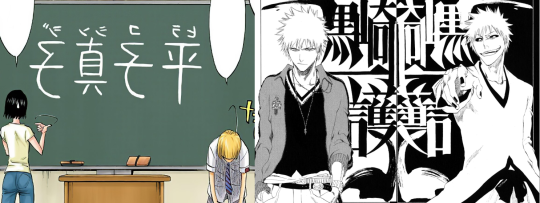
As an aside here, Sakanade(逆撫) has been kind of erroneously translated as “counter stroke” in English, which is technically accurate as a literal translation but is kind of needlessly vague; For one the word “Stroke” here specifically refers to the act of stroking as in petting, patting, or smoothing over, and not something like a sword stroke; secondly the “counter” here should read more obviously as “reverse,” “opposite,” or “inverted.”
Moreover, Sakanade(逆撫で) is an actual verb already, so it doesn’t actually need to be broken down in the first place. The word actually means exactly what it sounds like as well as having a colloquial use as, “rub the wrong way.” Yes, other than just meaning to literally “pet in the opposite direction” (as with petting a cat or dog from tail to head) it means “to irritate” or “to annoy,” (which the former action invariably does) and that is an apt description of Sakanade’s powers.
Anyway... About Hirako’s name not being about the meaning: the joke is that whether you write the name forward or backwards 平子真子 -vs- 子真子平, you still get Shinji(真子) out of it. As in, his name is still legible both forwards and backwards. Plus both kanji, 平 and 真 have horizontal symmetry, so they don’t change when mirrored..
⸻⸻⸻⸻⸻⸻⸻⸻⸻
Okay... let’s do an easier one...
Sarugaki(猿柿) Hiyori(ひよ里)

My personal favorite Visored, has a nice straight forward name Saru(猿) as I’m sure anyone amply familiar with anime knows means “Monkey” and the Gaki(柿) is the word for the fruit “Persimmon.” The image of a monkey in a persimmon tree references an old folktale present in various east-asian cultures about a greedy monkey who cheats other animals before eventually receiving its comeuppance at the hands of the animals it has wronged. In this case it’s reflective of Hiyori’s general image, sandles, track suit, decidedly tomboyish and unladylike; the “mountain monkey” is a poor, rural character type in Japan, not dissimilar to the American hillbilly of the Appalachia.
In that same vein, the name Hiyori(ひよ里) has a peculiar rural slant to it, in that it uses hiragana in place of the first component. The ri(里) is a common place indicator in surnames meaning “village” or “hamlet” but like many Japanese surnames that reference landmarks like -kawa(川)“-river,” “-yama”(山)-mountain,” and “-da”(田)”-field,” the important part isn’t actually the locale but the descriptor preceding it; Which mountain? Which river? Which field? Which village? In the case of Hiyori, it’s not clear... The fact that the village she appears to be named after doesn’t have a kanji again lends to this impression that, like the peasants of Soul Society’s Rukongai, the person who named her didn’t know how to read or write kanji.
⸻⸻⸻⸻⸻⸻⸻⸻⸻
Muguruma(六車) Kensei(拳西)

I think this one has gotten pretty good visibility in the fandom already because of the relation with Hisagi Shuuhei. The eventual explanation of Hisagi’s 69 tattoo would be that it was copied directly from Kensei’s, and that Kensei’s comes from a mix of his name Muguruma, and the fact that he was captain of the Gotei 13’s 9th squad. (Personally I don’t like this explanation, and I think there’s pretty reasonable cause to assume this was a later decision and not a part of Kensei’s original conception or design.) But the reason behind that being Muguruma(六車) Mu(六) which is the Japanese numeral “6″ and Guruma(車) meaning “wagon” and later updated to mean “car.” In the Turn Back the Pendulum sidestory, this name is played upon in how Kubo styled Kensei’s 9th squad as a Bousouzoku(暴走族) the term for a Japanese biker gang (although they often include sports cars), where the “Six Car” reading becomes emblematic of his gang.
There’s a lot about the Bousouzoku that is culturally specific to Japan, but much of the familiar American cliches do actually carry over. One distinct aspect of how the Bousouzoku opperate however, is that they are predominantly a youth culture phenomenon, as any wide spread, organized criminal activity among adults quickly steps on the toes of the much better established Yakuza scene. For this reason it is very rare for Bousouzoku to persist in direct group activity into their adult years, although often bikers become easy recruitment targets for Yakuza.
Kensei(拳西) is actually an odd one for me. It’s both super straight forward yet somehow together really obtuse. Ken(拳) for “Fist” and sei(西) for “West;“ both are pretty singular in their meaning, so it’s not like there’s any uncertainty to what each one means, but I can’t make heads or tails of the two together. For one, Ken(拳) is usually something you’d see put on the end of a compound, and when it’s used that way it tends to denote a kind of martial arts style or technique. It might still be meant to read as “Western Fist” or essentially “Western [style] Fist” and Kubo just liked the sound of Kensei over Seiken. It might be a reference to the fact that Kensei’s original design was largely reminiscent of a kind of military look and feel, with a combat knife for a zanpakutou, short hair, combat boots, and pants that look like they could be part of military fatigues. (the tank top sorta throws the look off, though.) But this was a theme that was dropped by the time the Visored got reincorporated into the story after their long absence.
⸻⸻⸻⸻⸻⸻⸻⸻⸻
Yadoumaru(矢胴丸) Risa(リサ)

...is another odd one. Her surname, Yadoumaru(矢胴丸) has pretty clear implications, Ya(矢) means “arrow” and dou(胴) means “hull” as in the part of a ship, and maru(丸) doesn’t actually have an explicit meaning. The kanji does generally mean “round” or “whole” both in reference to a circle, but it is most notably a suffix used in naming both naval ships, and frequently boys. Given the rest of the name the imagery seems clear, Yadoumaru(矢胴丸) is meant to read as “Arrow-Hull Ship.“* And although the uniform has heavy ties to school girl aesthetics and fetishism (which in turn link to her preoccupation with adult books) the tie here actually seems to be to the origins of the Japanese school girl uniform as a modification of the European naval uniforms introduced to Japan in the 1800s.
*edit: I’m an idiot. A Yadou(胴丸) is the sleeveless chest plate and skirt piece in traditional samurai armor, which also carries over into kendo sports armor.
Adding to this, the name RISA (sometimes romanized as LISA) being written in katakana and not kanji or even hiragana works together with the naval associations would seem to imply she’s of mixed birth? Possibly the daughter of a foreign naval officer stationed in Japan, hence a Western name and a ship as a surname? In fact, most Japanese ships would be named after some mythical figure or indeed named like a person, so the literal descriptor of “Arrow-hull” actually sounds like what someone would call a ship they didn’t know the name of, tacking “-maru” on to the end.
⸻⸻⸻⸻⸻⸻⸻⸻⸻
Let me also take a moment here to complain about the fact that Kubo originally wrote Rabu(ラヴ) and Roozu(ローズ) as katakana, pretty clearly denoting them as the English words LOVE and ROSE and while those seem pretty implicitly like nicknames it also implied in conjunction with their designs that they were both foreigners. So the fact that he retconned them to being nicknames based on more conventionally Japanese when he decided to make them previously SoulSociety shinigami names bugs me... But that being said
Aikawa(愛川) Rabu(羅武)

Man, what is it with Kubo and black people and “love” gimmicks? Zomarri’s Amor, and PePe’s The Love, Love’s whole thing... The name Aikawa(愛川) means “Love River,” and Kubo’s clever shorehorning of kanji into the phonetics for Rabu that he’d already used for the nickname Love use Ra(羅) for “silk,” but specifically a thin or sheer kind, and bu(武) for “warrior”/”soldier.“ The associations with sheer silk and negligee seem very intentional, so his name really is basically “flowing love, [sexy] silk soldier.“ And that’s it, it’s actually super straight forward. I dunno why he looks like an unemployed slacker, in a tracksuit and sneakers, lounging around reading manga, though.
⸻⸻⸻⸻⸻⸻⸻⸻⸻
Otouribashi(鳳橋) Roujuurou(楼十郎)

This might be my favorite as far as name games within the Visored. The given name Roujuurou(楼十郎) means “Watchertower 10 Son;” Rou(郎) being an exceedingly common suffix in boys names meaning “son.” (this is incidentally how anyone with a rudimentary familiarity with Japanese knew for certain Yuushirou(四楓院) was a boy at first glance, where as a bunch of other people thought he was a girl. In case any of you were around certain fandom circles for that whole drama... More on him later though, because he’s got a fun name too.) It’s not super clear if the arrangement here denotes the “Son of the 10th Watchtower [family],” or the “10th Son of the Watchtower [family].”
The surname Otouribashi(鳳橋) is a great little work of poeticism, where Outouri(鳳) is the Japanese name of the Chinese Feng(鳳) which in the most colloquial sense could be translated as “Phoenix,” but there’s a little more to it than that...
See, the Feng is itself the male half of the mated pair of mythical birds together called the Feng-Huang(鳳凰). The Japanese pronunciation Outori is actually directly taken from Ou(王) meaning “King” and Tori(鳥) meaning “bird.” The mythical Feng-huang is in fact king of birds, but more broadly represents a union of yin and yang, and is a common visual element of Chinese weddings evoking harmony. As a part of this theme of unity it is said to share features of many different birds, and also of the 5 fundamentally opposed colors associated with Chinese daoism and fengshui: Red, Blue/Green, Black, White, and Yellow. This particular feature has been tweaked over time to depict the Feng-huang as more broadly multicolored, and associated with the rainbow. (it’s also the basis of the Pokemon Ho-oh, if that wasn’t apparent) For a number of different mythological similarities, the Feng-huang have become erroneously thought of as “the Chinese phoenix,” but I’m not going to get into all that here...
So, getting back to the name, Bashi(橋) means “Bridge.” The, again false equivalence based, but more easily understood translation of Otouribashi(鳳橋) thus being “Phoenix Bridge.” But what is shaped like a bridge and directly associated with the Feng? A rainbow. His family name is just a really fanciful and kind of poetic reference to a rainbow. In conjunction with the “Watchtower” referenced in the name Roujuurou(楼十郎) I’m tempted to take to the meaning of “10th [Floor of the] Watchtower Son” as it implies a high floor, and in the common mythological motif of rainbows as actual physical structures, a high tower would be the sensible entry point to a rainbow bridge.
Also this is why he has a bird mask.
⸻⸻⸻⸻⸻⸻⸻⸻⸻
Kuna(久南) Mashiro(白)

Let me just come right out and say that I haven’t got a damn clue on this one. Mashiro(白) means “White.” Ku(久) means “long time,” na(南) means “South.” She dresses like a super sentai character, specifically one of the original Himitsu Sentei Goranger team, and her mask is a nod to Kamen Rider, with its antenna and big round bug-eyes. I don’t really see a connection with the name and the tokusatsu theme though.
Small aside, Tokusatsu is a genre of Japanese TV and film that was originally named for its emphasis on special effects like camera tricks and editing in post, used most noticeably in children’s shows like Super Sentai and Kamen Rider. That distinction became less and less relevant as special effects became more widespread, and so it is now used mostly to refer to live-action costumed super hero shows.
Super Sentai is btw the source material for the American franchise, Power Rangers, from which Saban Entertainment originally bought the footage that they would cut together with their own original footage, and later from which they would buy the costumes in order to shoot their own shows from scratch.
Also of note is that Ishinomori Shoutarou, author of the original Cyborg 009, was also the original show creator of Kamen Rider and Super Sentai. His work created the transforming(henshin) hero, the body suit and helmet aesthetic, and the heroic billowing scarf, effectively inventing the Japanese superhero almost single-handed.
⸻⸻⸻⸻⸻⸻⸻⸻⸻
Ushouda(有昭田) Hachigen(鉢玄)

Another funky one... “[To] Exist [in] a Shining Field” might be the best way to read Ushouda(有昭田)? Its really the U(有) that gives me trouble here, as it just means “Exist”/”Existance.” And Hachigen(鉢玄) seems to read Hachi(鉢) meaning “bowl” and Gen(玄) meaning “deep,” “mysterious” and in certain contexts “occult.” I’m not sure if that “deep” is really a physical deepness or just a sort of “profoundness” that would fall more in line with “mysterious” and “occult.”
Either way I think the general meaning is actually pretty clear, “bowls of rice from a shining field” evoke an image of kind of mythical field of magical produce, eating from which grants a kind of magical quality and sustenance. In other words, his name is saying that Hachi is such a huge guy and so gifted at magic because he ate a lot of food that grants magic power.
I have no idea why he has the tux or the shaved hair though. Stage magician? Fancy gourmand? But again then why the shaved head and the cross bones? And Kubo did eventually come up with for him is strangely Balinese looking? It seems reminiscent of Barong, king of spirits; A benevolent lion/bear monster that defends mankind from Rangda, the demon queen and master of blackmagic. But apart from the superficial appearance and broad ties to magic, there’s not a lot really tying the two together.
⸻⸻⸻⸻⸻⸻⸻⸻
It’s hard not to just go off on all the weird little design choices, and loose ends, dropped plot points, and retcon’d details that surround the Visored in Bleach. They really were just such a great concept utterly wasted by terrible pacing and some truly confusing priorities as far as publication goes, eithe ron Kubo’s part, editorial, or both... But that’s a story for another time...
#Bleach#hirako shinji#sarugaki hiyori#muguruma kensei#yadomaru risa#aikawa love#otoribashi rose#kuna mashiro#ushoda hachigen#visored
397 notes
·
View notes
Note
1/2 Hello! I've been silently visiting your blog for some time now and I would like to hear about your perspective on relationships (not only romantic but also friendships, etc) between people of certain countries. This might be such a weird message... Anyway, please, feel free to ignore this! Lol. Sometimes, I get the impression that it must be very difficult to reach a certain level understanding of the real world when it comes to individuals who come from such different backgrounds.
Anonymous said:
2/3 (LOL I talk a lot, I'm so sorry) OF COURSE, every place has its challenges and each person has a different experience, I'm not generalizing this in any way. But, don't you think that it can be difficult to take on the real world when your reality has been kind of """cushioned"""? There are countries that are obviously more privileged than others, and I could not help but think that it must be easier for some people in those realities to just ignore some issues...
Anonymous said:
3/3 (Again, sorry, please feel free to ignore lol) Anyway, this a damn long conversation, I don't want people to take this wrong way, it's just a thought and I would like to hear your opinion, since you have seen so much of the world. Everything has been so confusing and I just have lots of thoughts about it all lol. Having so much confusion can even change our personal relationships, so... Idk. Sorry! And excuse my english, it's not my first language. Thanks for the time haha have a great day!
What a lovely ask. God there’s so much to unpack here and I don’t even know where to start.
I think a few years ago, before I started to travel, I had this sort of mindset that like...we’re all humans. And I loved that we could all, at some level, relate to each other on common ground. We all needed love, companionship, support, we all needed encouragement and human interaction.
But I think as I started to travel, I realized what an incredibly privileged position that was--to assume that we were all, on some level, really quite similar.
I have been to some of the poorest corners of the Earth, for extended periods of time. And I realized that while I was searching for social acceptance, for love, for ambition, for support, while I identified these as basic needs that all humans can connect over--people were searching for food, for water, for a place where they could sleep for maybe just an hour and not worry about being kidnapped, killed, beaten, or forced into militia.
I have friends in all different countries, absolutely--but it is easy for me to find common ground with people in Sweden, with people in North America or Europe in general, with people in Asia. We are the fortunate, and we are the privileged(again--for the most part).
But when I go elsewhere, then yes, absolutely--I’m struck by how little I can relate to the people I meet there, but more than that, I’m struck by my own ignorance and privilege in assuming that common ground is common across the world.
It’s not.
I don’t know what it’s like to live in their circumstances. I’ve only had to do it for short amounts of time. I don’t know what it’s like to live in a constant state of fear. I don’t know what it’s like to starve. I don’t know what it’s like to not ever feel safe. I don’t know what it’s like to accept those circumstances as just a part of my reality.
To be quite honest--I don’t have close friends, in those parts of the world. Because while I can see and witness their pain as much as my privilege allows--I can’t sympathize. I don’t want to pretend like I can. As a privileged woman from the Western world, I do not for one second want to adopt their pain and struggle and pretend that it is my own. Pretend that I know what it’s like.
I don’t. I have no idea.
The only thing I can do is recognize that, and honour them. I can learn as much as I can during the time I spend there, with them. I can recognize that saying “all humans connect through kindness” is a privileged stance to take, and saying “all humans want love” is total bullshit. Love comes after survival. Love, as a need, comes after things like shelter and food and water.
But I can tell you, in my experience, the people who I--again, as a privileged woman of the western world--deem to have nothing, are some of the most willing to share what little they do have. I was invited to every meal. There was not enough food for them but somehow they made sure I had food on my plate. I didn’t honour their culture, because god that’s some bullshit and seems to imply that I believe my own culture is above theirs and that’s disgusting--but I did as they did. I ate the bugs, if that’s what they had to eat. I didn’t eat if they put food on my little banana leaf but didn’t have any on theirs.
And that’s not martyrdom. That was literally me just being fucking mortified that I would ever assume, in my privilege, that I had common grounds with people everywhere.
We don’t, boo. We just don’t. The only thing we can ever keep with us, is our humility and our own awareness of that exact fact.
4 notes
·
View notes
Text
Freedom Fighters - An Unceremonious Death
For the love of god let them die
Look, I like the Freedom Fighters. More the reboot than the preboot, they have less baggage, but still, I respect what they did. But if you’ve read my other dumb things you also know I think Red Dwarf USA had a real chance of working, so maybe I’m just insane.
Either way, this whole Rally For Sally business has been going around and disturbing the usual culprits from their dens and I feel I should say something.
“The American Canon“
This is a stupid sentence and yet thrown around as you like. There is no American canon, there is just “The Canon” and “Non-canon.” Believe it or not, the people who make the product get to decide what’s done with it and what is canon.
If you made something and then in France they made an entirely different story with concepts and themes you didn’t want to explore, you’d be hesitant about including or acknowledging it. Same with Sega of Japan.
But then why did Sega allow this to be made?
Well, I think this needs a tad bit of history behind it.
We’re going to the 90′s

Denim was in, the future was here, everything in 2000′s would be chrome and the Y2k bug was on the horizon.
Ohno
But Sega of Japan had an issue. Their arcade machines were selling like nobody’s business but they wanted that sweet console piece of the pie, but had no winning mascot. Alex Kidd, unfortunately, wasn’t moving as many consoles as they had hoped, god knows not enough to rival Mario.
They needed something cool, something different, somethi- It’s Sonic. You know it is, I know it is, I ain’t dragging this on.

It did well enough in Japan, but Sega was focusing on international markets with this game. It had a somewhat universal design, helped by the basis being Felix and Mickey Mouse which were popular around the world, with catchy songs based on both Japanese and American releases from the past.
It was going to be a hit.
Or... was it?
Did they need to do more?
Well, Sega doesn’t just have Sega of Japan. It had SOE and SOA as well. Europe and America respectively. Others too I’m sure but my memory’s off.
SoA and SoJ had a somewhat shaky relationship with each other, but then again, so did other companies back then. It was a new foray into public relations. Japan built the consoles that actually sold, America had to sell them, but there was a big gap between the countries, how things were interpreted, different values, and let’s not forget, American pride and greed.
AMERICA in the 90′s
SOJ needed this thing to sell big. Sonic was going to be a global success if they could help it. And let’s be honest, it was.
America had it’s own plans on what Sonic should be, and SOJ actually listened to some of them. Madeline Schroeder, product manager at the time for Sega in the US, actually went to Japan to say what she thought Sonic would be. As of this, they removed Madonna and Sonic’s tie-in with a band, as well as changing certain design traits in the US because “Sonic looked too Japanese.“
And then had the gall to call herself the “Mother Of Sonic”
Again, in a world where shitting on other people’s culture is a big no-no, and for good reason, how that managed to be fine is insane.
It’s a Japanese fucking product, Madeline.
Alongside this, as SOA hadn’t had much access to the Japanese backstories (although, the manuals should have been fine enough), when it came to marketing the games as an ongoing story (and ready in time for the cartoons they wanted to push) SOA made their own Sonic Bible, for use outside of non-Japanese territories.
This would have the seeds of what most people know, Freedom Fighters, Eggman once being good, Sonic being part of the good fight, etc.
[Astoundingly, when they made the cartoons and everything, Fleetway would be the one to actually stick closer to this than Archie/Satam/Underground/Aosth ever did so who’s talking about canon now huh]

Japan didn’t really notice nor take heed. One could make a good case for their complete obliviousness to what SOA was doing. You can tell because absolutely nothing from the bible/comics/magazine ever appeared in a Japanese Sonic game. Spinball was Sega Technical Institute, an American Division. Not Sega of Japan.
On top of this, as I see a bunch of people who go “Sega is disrespecting the American canon”, interesting fact. In Europe and Japan, the manual for Sonic CD clearly states Amy Rose is in the game. Sega of America actually edited this to say Sally, despite not going through and changing the sprites. If that’s not disrespect towards the creators of the games I don’t know what is.
The Canon
The problem I find with this is that, let’s be honest, if we had to look at this from an objective viewpoint:
Japan released a game.
America sought to profit off it, but didn’t like it was very much Japanese, not American.
They changed the story to be more American themed, changed the art design to look more American drawn, and ignored the Japanese additions to the games by editing out the Japanese characters in the manuals.
Because they wanted to profit off a different culture’s work by changing it wholesale so it didn’t resemble the culture it came from.
Nothing about SatAm’s premise or creation says anything about the original material it came from, just heavily adapted without any input from it’s creators to resemble a more American product.
You know how Japan saw Sonic?

This cute lad who acted more like a cartoon Felix the Cat type figure.
Now I get it, especially in the 90′s, everyone was localising. The markets weren’t as much the same, god knows they gave Ratchet attack eyebrows to be appealing etc.
But this was so anti-Japanese that the fact they were profiting at all from a Japanese product is insane.
Adventure
Ha
Back in Japan in the 90′s, they didn’t really have much of an idea what they were doing with the canon. They had plans but they seemed to be not as stable as they would have liked. The amount of games they were pumping out with different Eggman attacks and characters and if the GG games fit in with the MD games-
They needed something a bit more stable.
So when it was their time for their biggest game yet, they started to reign things in. In Japan. In Europe.
In America.
Sonic Adventure would be the basis for the stories for the next decade or so, with some revisions on what came before, what was mainline, what have you.
At this point, SOA’s cartoons had all died and the only thing remaining in the Sonic canon from that time was the Archie comic, still ongoing. But yet America still pulled this stuff off.
In the original script, Eggman is still Eggman. None of this “I AM DOCTOR ROBOTNIK, GENIUS OF THE WORLD” schtick.
No changing the manuals this time at least, so they’re getting better.
Over time, the only surviving things to come out of the canon, which Sega was nice enough to do considering, was
- Chilli-dogs - I HATE THAT HEDGEHOG - Robotnik being Maria’s surname
Didn’t you have something to say about the Freedom Fighters?
Why yes I do.
So, the Freedom Fighters for me, as much as I like them as , represent an American centrism. Not only was America not a Sega dominated market, for Nintendo did better and Europe was buying Sega consoles like candy, but the characters and show weren’t that popular outside the country anyway.
Ask someone in Europe in the 90′s who Sally Acorn was and unless they had access to a specific channel they wouldn’t have the first idea. Amy Rose, for sure, she was in the games.
I didn’t know who Sally was until Mega Collection Plus came out, and the UK STILL manages to get Sonic games in the top of the charts when they come out.
Aosth was shown more abroad with more appeal, the comics weren’t sold internationally, let alone in Japan.
To be all “But these characters cemented the Western fanbase” is mental.
The comics sold somewhere in the tens of thousands in their hey-day. At the same time, Sonic games were selling millions. The comic and show are so old that unless you were part of the 20,000 buying the comics recently or pirated them, you don’t even know who they are.
Fleetway was the only Sonic comic we got in the UK, and there’s more fans that have grown up with Sonic Adventure being the basis which had absolutely no inspiration from the Western products.
These characters are relics of America taking the mick out of a Japanese product in order to make more money and produce shows.
To say they’ve made a big impact on Sonic in the world is really stretching it.
F.A.Q
But you said you liked the FF’s!
I do, but in the same way I like AU’s. It was interesting, of it’s time and it said a lot about the culture it was made in. Like, comparable to Tails gets Trolled or Fleetway
B-but I really like the FF’s!
Good for you, don’t let me stop you. Again, I like a bunch of the stories.
Are you a Japanese purist?
Fleetway is cool and I liked the Boom show, and I liked Robotnik better than Eggman as a name.
I heard that some Japanese fans actually liked the FF’s though...
And more power to them. Again, Red Dwarf USA does a lot to shit on what made the UK version so good but I respect what it tried to do. Again, even I like the FF’s to an extent.
Why did you write this all out?
Seeing all this Rally for Sally has brought out all the insane people who shout at SOJ for being gits for not respecting the American canon despite the American canon being born from a disrespect to the Japanese creators.
What about IDW?
Ironically I actually liked Reboot more but also I was younger when I read them.
What do you think of Tangle and Whisper getting in?
I need to read more of IDW but they’re good enough. As for getting in the games, these designs were vetted and passed through SOJ first and the comic is overseen by them. On top of this, T+W don’t come from a place of SOA taking the mick.
But Sega has used these characters before and ESTABLISHED this as canon why are they changing it now-
I see this a lot, usually with certain people. Dobson’s a good example of why this is stupid. When the Japanese revert changes made to characters like Mario/Zelda/Samus by the West, they didn’t radically change their personalities, they just reset them to what Japan intended.
Japan never intended for the FF’s, the three heavily contrasting cartoons and Knuckles is Jesus Christ Superstar.
They just reverted him back to the sole guy on Angel Island.
Do you think Sally should get in to Sonic Dash?
No more than I think Tekno or Sonia does. They’re old, irrelevant, gone. If they do get brought in for a cameo I’d be happy enough, I like dumb nods to non-canon things.
However, there are crazy people out there and you give them an inch and they’ll take a mile. Best to leave it.
Hotel?

2 notes
·
View notes